#but i DO mean that they lack many of those good and kind qualities commonly associated with rhine's creations
Explore tagged Tumblr posts
Text
haha and what if i pointed out the fact that the only of rhine's creations who lacked many morals, ethics, empathy and such, were the ones who she'd never truly interacted with and ignored/incidental creations; Like. just the difference alone, between the golden wolflord (who is established to have been a mistake,) and it's insistence on invading teyvat, and only retreating after being injured (and, mind you, that was just to recuperate ! it's clear they would have continued had they been able to) V. the way both Elynas and Durin (one of whom are ESTABLISHED as one of her ! masterpieces !) felt immediate remorse and finding out they'd harmed the world around them, and LET themselves be killed, is. very telling!
#“her masterpieces” and their most defining feature is being so painfully human despite not being truly human at all#-> not to say they completely lack everything ! because they dont!#but i DO mean that they lack many of those good and kind qualities commonly associated with rhine's creations#the difference between subj two and albedo are enough on its own too#rhinedottir#durin#elynas#golden wolflord#rhinefamily
10 notes
·
View notes
Text
"For The Children" Is A Puritan Dogwhistle, And It's Time You Stop Pretending People Who Use It Are Acting In Good Faith.
They're not.
Not once, not ever, nor has any policy, political move, bill, terms of service update or edit to an EULA agreement done under this banner been made with good intentions. "For the safety/good of children" is what's commonly referred to as an "Emotional Appeal", a logical fallacy most of you learn about in grade school. Corporations and politicians, at least in America, will happily strip away your autonomy without a second thought while simultaneously ignoring direct and real dangers that many children face literally every single day. They get away with it too, because gaslighting in American politics works.
There's no grand agenda, no chemical in the water nor some mind control via 5g tower by some shady cabal to harm your children.
You know what kids are really dealing with right now?
There's been 64 school shootings in the US so far just in 2024. The number of kids facing food scarcity or only getting a meal at school (often on the free/reduced price tier) has surged since the 2019 lockdowns. More than 1.2 million kids in school right now are homeless. Schools are underfunded by $150 billion annually, meaning kids don't even have access to the resources necessary to receive a quality education.
These are just the causes I can personally think of that we should be investing in "for the children", and yet as literal bodies pile up every year, kids starve and freeze outside in the elements, I've watched our politicians just shrug and say nothing can be done while actively infringing on the privacy and safety of it's citizens.
Instead of doing something about gun control, we've got militarized police in schools and talk of allowing teachers to carry firearms. Instead of taking my tax money and at least feeding the kids, I've watched them be fed stuff so lacking in nutritional value it might as well be dirt. I've seen politicians move to keep the holocaust out of textbooks and reduce the horrors of war to a few paragraphs-always with this country as the winners, the good guys, the MCU equivalent of the avengers coming to save the day. Don't even get me started on housing those homeless children. If the US doesn't care about kids being shot to death, it sure as hell doesn't care about giving them adequate shelter.
I'm not so dumb as to assume there's a single solution or a single cause to any of this, but I'm also not ignorant to the fact that every single fucking time I've heard "for the safety of kids" or "for the good of the children" used by someone, they're about to do something fucking hideous to all of us and get away with it. They're about to rob you of your rights, your humanity, your name and culture if they think they can. And they're gonna get away with it too, because what kind of monster would ever argue against the safety of kids?
"For the children" is a conservative dog whistle. It always has been, it always will be, and every time you see it used it's time to start harassing the shit out of the people saying it by asking them what they're legitimately, actually, factually doing for kids. Because there's a damn good chance their entire argument is built on a throne of corpses.
36 notes
·
View notes
Text
Arthur Machen's Idea of Evil
If you’ll indulge me, I’d like to explain one of my favorite ideas in fiction: the idea of positive evil.
The Christian conception of evil is, more often than not, one of negation. Evil is a lack of goodness, a turning away from God. Adam and Eve were born sinless, but acted against God’s will, and so fell from innocence and grace. Thence came Original Sin, an imperfection that was inherited by all humankind. A defect, a blemish—an alteration of what would have been their natural state.
For many people, this is the familiar way of viewing sin and evil, even if they aren’t familiar with all the strange theological offshoots that came from following it to its logical conclusions.
I’m not going to discuss those here, though they’re certainly worth investigating. Rather, I want to talk about how the late Victorian author Arthur Machen, regarded by many as the “grandfather of weird fiction,” created horror and mystery by rejecting this doctrine, and entertaining the possibility of evil with positive substance unto itself.
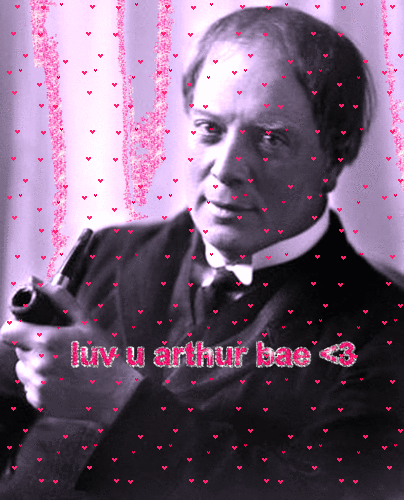
Picture very much related.
What separates crime from sin, vice from evil, animal fear from existential terror? Much of Machen’s horror fiction follows this line of inquiry in one way or another, but he answers it pretty directly in the prologue of The White People. It’s structured as a short Socratic dialogue between the author stand-in Ambrose and his evening visitor, Mr. Cotgrave:
‘I think you are falling into the very general error of confining the spiritual world to the supremely good; but the supremely wicked, necessarily, have their portion in it. The merely carnal, sensual man can no more be a great sinner than he can be a great saint. Most of us are just indifferent, mixed-up creatures; we muddle through the world without realizing the meaning and the inner sense of things, and, consequently, our wickedness and our goodness are alike second-rate, unimportant.'
'And you think the great sinner, then, will be an ascetic, as well as the great saint?'
'Great people of all kinds forsake the imperfect copies and go to the perfect originals. I have no doubt but that many of the very highest among the saints have never done a "good action" (using the words in their ordinary sense). And, on the other hand, there have been those who have sounded the very depths of sin, who all their lives have never done an "ill deed."'
[...]
'I can't stand it, you know,' he said, 'your paradoxes are too monstrous. A man may be a great sinner and yet never do anything sinful! Come!'
'You're quite wrong,' said Ambrose. 'I never make paradoxes; I wish I could. [...] Oh, yes, there is a sort of connexion between Sin with the capital letter, and actions which are commonly called sinful: with murder, theft, adultery, and so forth. Much the same connexion that there is between the A, B, C and fine literature. But I believe that the misconception—it is all but universal—arises in great measure from our looking at the matter through social spectacles. We think that a man who does evil to us and to his neighbours must be very evil. So he is, from a social standpoint; but can't you realize that Evil in its essence is a lonely thing, a passion of the solitary, individual soul? Really, the average murderer, quâ murderer, is not by any means a sinner in the true sense of the word. He is simply a wild beast that we have to get rid of to save our own necks from his knife. I should class him rather with tigers than with sinners.'
'It seems a little strange.'
'I think not. The murderer murders not from positive qualities, but from negative ones; he lacks something which non-murderers possess. Evil, of course, is wholly positive—only it is on the wrong side. You may believe me that sin in its proper sense is very rare; it is probable that there have been far fewer sinners than saints. Yes, your standpoint is all very well for practical, social purposes; we are naturally inclined to think that a person who is very disagreeable to us must be a very great sinner! It is very disagreeable to have one's pocket picked, and we pronounce the thief to be a very great sinner. In truth, he is merely an undeveloped man. He cannot be a saint, of course; but he may be, and often is, an infinitely better creature than thousands who have never broken a single commandment. He is a great nuisance to us, I admit, and we very properly lock him up if we catch him; but between his troublesome and unsocial action and evil—Oh, the connexion is of the weakest.'
It was getting very late. The man who had brought Cotgrave had probably heard all this before, since he assisted with a bland and judicious smile, but Cotgrave began to think that his 'lunatic' was turning into a sage.
'Do you know,' he said, 'you interest me immensely? You think, then, that we do not understand the real nature of evil?'
'No, I don't think we do. We over-estimate it and we under-estimate it. We take the very numerous infractions of our social "bye-laws"—the very necessary and very proper regulations which keep the human company together—and we get frightened at the prevalence of "sin" and "evil." But this is really nonsense. Take theft, for example. Have you any horror at the thought of Robin Hood, of the Highland caterans of the seventeenth century, of the moss-troopers, of the company promoters of our day?
'Then, on the other hand, we underrate evil. We attach such an enormous importance to the "sin" of meddling with our pockets (and our wives) that we have quite forgotten the awfulness of real sin.'
'And what is sin?' said Cotgrave.
'I think I must reply to your question by another. What would your feelings be, seriously, if your cat or your dog began to talk to you, and to dispute with you in human accents? You would be overwhelmed with horror. I am sure of it. And if the roses in your garden sang a weird song, you would go mad. And suppose the stones in the road began to swell and grow before your eyes, and if the pebble that you noticed at night had shot out stony blossoms in the morning?
'Well, these examples may give you some notion of what sin really is.'
[...]
'You astonish me,' said Cotgrave. 'I had never thought of that. If that is really so, one must turn everything upside down. Then the essence of sin really is——'
'In the taking of heaven by storm, it seems to me,' said Ambrose. 'It appears to me that it is simply an attempt to penetrate into another and higher sphere in a forbidden manner. You can understand why it is so rare. There are few, indeed, who wish to penetrate into other spheres, higher or lower, in ways allowed or forbidden. Men, in the mass, are amply content with life as they find it. Therefore there are few saints, and sinners (in the proper sense) are fewer still, and men of genius, who partake sometimes of each character, are rare also. Yes; on the whole, it is, perhaps, harder to be a great sinner than a great saint.'
'There is something profoundly unnatural about Sin? Is that what you mean?'
'Exactly. Holiness requires as great, or almost as great, an effort; but holiness works on lines that were natural once; it is an effort to recover the ecstasy that was before the Fall. But sin is an effort to gain the ecstasy and the knowledge that pertain alone to angels and in making this effort man becomes a demon. I told you that the mere murderer is not therefore a sinner; that is true, but the sinner is sometimes a murderer. Gilles de Raiz is an instance. So you see that while the good and the evil are unnatural to man as he now is—to man the social, civilized being—evil is unnatural in a much deeper sense than good. The saint endeavours to recover a gift which he has lost; the sinner tries to obtain something which was never his. In brief, he repeats the Fall.'
Emphasis added by me.
Sin, in Machen’s eyes, is a violation of the most fundamental laws of our universe—the principles that determines what is good, what is natural, what is up and what is down. In Platonic terms, it is a violation of the reality that proceeds from ‘God,’ the One, the Good.
To break these laws is not merely to turn away from God, but to turn towards something else. Some entity or principle that is wholly foreign to the Good, and is intruding upon our reality, imprinting itself upon matter and spirit alike.
The sinner turns towards this Evil, just as the saint turns towards the Good, because it induces the same spiritual ecstasy, just in the opposite direction.
You are making contact with a great spiritual Truth, be it supernal or infernal or simply weird, and the very essence of your being is undergoing a process of sublimation in accordance with that principle.
It’s a terrifying idea because it empowers evil in a way that Christian doctrine simply does not allow, and it acknowledges that depravity is, on some level, empowering. It’s not just that we want to get away with breaking the rules. It’s not that we want to follow our appetites without regard for the harm that it may cause. No, sometimes human beings want to commit real violence, spiritual or physical, simply for its own sake—just like we do good things for the sake of goodness.
Attributing that impulse to the influence of a transcendent law or entity, of the same kind as the One, presents an existentially perilous universe. Suddenly we are beset from all sides by forces from outside our reality, as infinite as there are directions, all of which threaten to change the essence of who and what we are. Acknowledging these intrusive powers could mean succumbing to them, and becoming something as foreign to humanity as blossoming cobblestones are to the laws of physics.
Someone beside you, to all appearances human, could be wearing that form only externally, and temporarily. They could in fact belong to something that should not exist in our world at all. And if given the chance, they would discard their human face and show you something that should not be manifested in matter at all.
Chilling, isn’t it?
I was going to talk about this idea in fiction besides Machen’s—I actually see some echoes of it in The Legend of Zelda: A Link to the Past, of all things—but this is already a fairly long post. I’ll save it for another time.
To those who bothered to read this far, what are your favorite examples of ‘positive evil’ in fiction?
30 notes
·
View notes
Text
I feel like fanworks of any medium in any fandom can be an inherently double-edged sword and the reason why, in a way, I'm glad I haven't tried to religiously pursue it.
On the one hand, it's a beautiful example of dedication, creativity, and often otherwise undiscovered/overlooked talent. It can also be a legitimate stepping stone to bigger things or, in a few lucky cases, the start of a career that utilizes those same interests or talents.
On the other hand, much of the audience has extremely specific desires and is commonly in flux in ways that some other areas of life and society don't have an exact equivalent for. To be blunt, they're really damn fickle sometimes.
You can be dazzlingly, brilliantly skilled at your craft and have good relations with your admirers/followers/clients, but if something else captures their attention for a sustained amount of time, you either have to adapt to what they want or accept that you might've lost that connection with that particular person or persons.
Some people adapt to other fandoms just fine and continue to enjoy that dynamic. Some even ride a "wave" effect (i.e. their own personal interests coincide with fans') as a new fandom crops up or an old one surges in popularity again. I wish those people all the best because that, too, is beautiful to see.
But for lack of a better word, it's problematic for some creatives. Y'all like to say "death to capitalism," but artists (*general term meaning any people who make stuff in any medium) doing things for money are, in fact, technically participating in capitalism in some shape or form. That's just how it is.
And that's OK. It's OK to try to make a living from things you like for the simple purpose of paying bills and eating 3 times a day and not needing to sleep in an alley. That's not a vice and it sure as hell isn't grounds for canceling.
I've seen so many shitty takes on this about how fans are entitled to fully rendered OC portraits or an entire 50k novel or a whole-ass crocheted blanket or an album-length music project for free because "*nonchalant shrug* I simply don't believe in The System(TM)," with no regard for the logistics involved and no understanding that the time it takes to make stuff is time that can't be used on other things (whether that means employment, sleep, eating, or basic mental health self-care).
There are people online - and especially here - who scrape by at a subsistence level by making art/crafts or writing fics or coding IFs or writing music. Some artists (*general term meaning any people who make stuff in any medium) do it specifically because they have a disability or health problem that precludes them from other options. Some are autistic or are dealing with other things that fundamentally impact how they function as a human in the world.
Translation: some people literally can't just yo-yo into a new subject at the whim of fandom trends. It literally doesn't compute for everyone. They're faced with the choice to force themselves into other subjects just to maintain connections/a little money or to become legitimately interested in said thing "too late" when the height of fandom enthusiasm has long since peaked.
I used to think that people just meant politics or cancel culture when they said "fandom is kind of like high school," but now I get it: there's a distinct popularity contest element to it - or there easily can be one - not necessarily about the quality of the creatives' finished expressions or even fans' personal tastes of those expressions, but the level of fandom involvement and population size itself.
It's no one's fault that it happens and it's usually totally innocent and incidental. It's also not necessarily a bad thing - far be it for me to discourage people from moving on to things that are better for their mental health or move away from things that were bad for it. But it's inevitable that some are left behind in the dust from time to time, even if the other/new fandoms make every effort to be welcoming.
The basest advice you often get is "go with the flow," but some people simply can't do that. They pour their hearts into a particular medium or niche topic or inspiration source because that particular Thing(TM) clicks for them in ways that other stuff doesn't. It's not as simple as "yeah sure w/e I'll draw the little space man today instead of a salmon."
So idk I would just suggest that, as one example, when y'all want to get an OC portrait and the artist you want to make it explicitly states which fandoms they can do and yours isn't on their list, at least ask NICELY if they'd be comfortable trying something new. Don't barge in and pressure them, because we tend to already pressure ourselves more than our due.
You'd be amazed how many people don't grasp this.
2 notes
·
View notes
Text
I mean, the post doesn't come off as identity politicking to me? Unless you're looking at the identity group of alive people anyway. You could argue that guys was meant to complain about male authors, but those posts usually bluntly complain about men (or white men specifically) rather than a term that can be used more sex-neutrally, and she's complaining on behalf of modern authors rather than singling out a group like BIPOC women or whatever.
And like... those are two very impactful works in the genre that absolutely can be credited with much of its expansion and success, with a clear influence on many of the works that followed it. They've lasted for decades while a lot of the books that have had successful numbers since have gone on to be footnotes in discussion of the genre, if not forgotten altogether. There's a valid reason why stores would choose to prioritize very successful stories that are known to be well crafted and resonate with people to this day over stories that are more narrow in who they speak to or have shallower world building--which is most of them. Especially during a time when people have less spending money, and when they're trying to make it as a physical store selling physical books with fucking Amazon and its Kindle Unlimited service as competition. There's a logic to thinking readers who still like physical shopping and holding paper books are also going to appreciate classics.
But it is also a fair complaint for those currently living authors. B&N changed how they stock books a few years back to (shock and horror) prioritize titles that have a track record of already selling well. The overwhelming majority of any work in any medium is, well, mid, but there are always new gems that could be coming out. With the current state of the publishing industry and their increased dependence on the author to be an influencer and do their own marketing, a work with the power of Wheel of Time or Lord of the Rings might have come out in 2021 and languished in obscurity due to lack of interest by the publisher in properly advertising it, and now you can't find it on shelves because B&N is cutting back on what they stock to bank more on things that they already know will sell.
(Kind of like the criticism of Hollywood being overdependent on reboots and sequels of proven IP. Except book world tends to leave a little more control of those IP in author hands, so you get bi-annual releases of new collectors editions of popular big name series instead of forced sequels.)
Granted, word of mouth sales are not a good thing to hedge your success on and the odds of bookshelf discovery being what makes or breaks your career rather than getting good marketing, or the promotion of an influencer, or just being put on one of the display tables rather than a shelf is going to make more of a difference. But it still helps to actually have your book be physically available in a store if you're hoping for people to buy it.
Basically, while most of the people bemoaning the situation probably weren't going to be the next great author anyway and B&N is catering to their audience by making the popular books widely available, it is still a real and valid complaint that industry milking the success stories is overshadowing new author's chances to get more readers.
Also, while I haven't read them, Fonda Lee's books are pretty commonly placed on most big fantasy personalities' best contemporary fantasy lists. I couldn't say where her writing ranks quality-wise when placed against the genre classics, but I wouldn't dismiss her out of hand as just being jealous that she can't tell a good story. As I understand it, her books sell well. This all comes across more to me like an author who has seen success trying to raise awareness for how the current state of the book industry (the book selling side, in this case) can thwart the chances of discovery for newer authors in general, rather than complaining about how she personally was slighted, or how some identity group is being targeted.
TL;DR reads more like common griping about the state of the book world and not identity politics.
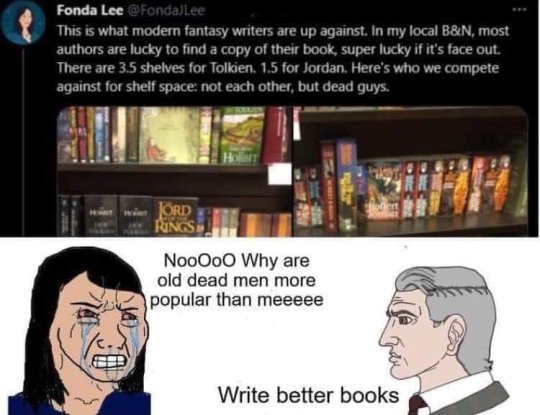
454 notes
·
View notes
Text
Part 3: Ring’s Biology and Possible Origins
In the world of Ring Fit Adventure, there exist monsters, ghosts, cyborgs, robots, gods, a curious array of animals, human beings of enormous size…and Ring. Ring—a creature so entirely unique, he fails to fit into any of those categories.
Everyone has their own idea as to what Ring is, and as to where he came from. So here’s mine.

(Spoilers for the end of the main storyline. Various postgame dialogue spoilers beyond that.)
If we’re going to talk about where Ring might have come from, it makes sense to look for clues in what he’s presented as. Physically, and subtextually. So let’s take it from the top.
Stepping away from the confines of the game, Ring’s shape is based off a Pilates ring, a piece of exercise equipment who’s history dates back to nearly a century ago, as of the game’s release. It was invented to help rehabilitate wounded soldiers through physical therapy following World War I. Design-wise, though…Ring’s face draws heavy inspiration from depictions of Ancient Inca art. Specifically, he looks a lot like the figure atop this ceremonial tumi knife.
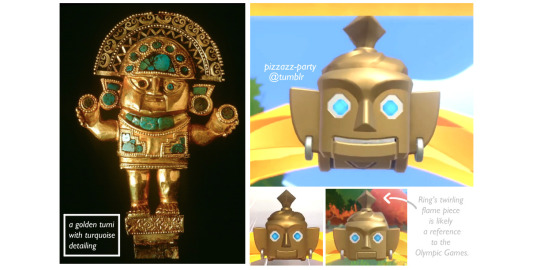
The prominent nose. The familiar jawline. A headpiece bisecting the brow. The blue commonly set into the eyes of the art. The ears—heavy earrings were unisex among the Inca nobility, resulting in long, stretched lobes. But most importantly—the statue is gold. And in the ancient Inca Empire, gold was revered as being sweat from the very sun itself. Metal nowadays is often associated with machinery, with invention. But raw metal has always been a fruit of the earth, as natural as any wood or leaf. The Inca took it a step further. They thought of gold as mystical.
Likewise, Ring’s design is meant to invoke these traits. Despite being made of metal, Ring visibly lacks gears or wiring or nozzles or hatches. His mouth may have a hinge and his flaming little hair piece may spin around. But in terms of “build,” Ring (the magical metal donut) has more in common with Pinocchio (the magical wooden puppet), than with an actual machine.

On a surface level, Ring really is best described as a “magical creature.” He’s obviously not made of flesh and blood. But he’s alive in a way that the closest comparison—sentient robots—just aren’t. Ring sweats, breathes, sleeps, eats. He ages. His metal face flexes and grows and shrinks as he speaks. Ring wields exercise energy, much in the same way that humans do, and more. He crafts, enhances, and stores things with it. Its raw essence flows through him like a fiery kind of lifeblood.
Ring’s not a human or a cyborg. He’s not a monster or a ghost or an animal. He’s made of metal like a robot, and that’s about it. And while Ring may (presumably) have the long life of a god, he lacks everything else. Right down to the proper shape and abilities. Ring, whatever the specifics, is a “magical creature” that exists in a class of his own. We never ever meet another being quite like him.
…At least. That’s what I used to think.
———
The thing with Ring is, it’s hard to tell whether he’s actively omitting facts or just forgetting them. He’s got a terrible memory. But he also as good as lies to us in the beginning, pretending as though Dragaux’s just some enemy to him.
So here is what I understand.
We meet Ring, and he and Dragaux are positioned as these perfect opposites, as perfect enemies. Ring builds others up, and Dragaux tears them down. Dragaux is flashy, an eyesore, the purple to Ring’s yellow, and yet he steals the stage every time. He’s a jerk, but he’s Ring’s jerk. We show up to every boss fight because we are invested in his story, his opinions, his downward spiral.
And that’s our first mistake, really. Because Dragaux’s accent color isn’t purple, it’s pink. Because Dragaux’s opposite isn’t Ring, it’s Trainee. And Ring’s real foil was never Dragaux, but Dark Influence itself.
———
Have you ever thought about how strange it is, this particular parasite. From a narrative standpoint, I mean. As much as it’s referred to as “Dragaux’s influence” or “Dragaux’s aura,” Dragaux is only its latest meal, not its source. And that meal has been lasting anywhere from decades to a century, at least. Dark Influence is, by nature, negativity incarnate. It could be as old as the hills. Older, maybe.
Dark Influence is voiceless, faceless. A parasite composed of pure negative exercise energy, it can theoretically exist on its own. But it thrives best when entrenched in the heart of a host. Its host—a physical creature that, once ensnared, starts exhibiting traits that belong to the Influence: like great swathes of flame in its signature color.
Does that not sound. Familiar.

Because Ring and Dark Influence? Fulfill eerily similar roles, in regards to their syncing partners.
Both of them harness their partner’s exercise energy. Both of them augment the abilities of their partner. But unlike Ring, who’s always actively helping Trainee in precise and creative ways…Dark Influence doesn’t care. I’m not sure if it can give a care about anything that doesn’t include “amassing power” and “spreading itself.” (And I think those are just instincts. I’ve yet to see proof that this thing has anything approaching a complex personality.) But whether or not it cares about Dragaux, it’s fully anchored within his body. It shares its strength with him because there’s nowhere else to store it.
Because unlike Ring, Dark Influence lacks a physical body of its own.
And that thought. How it “lacks” a body. Just sort of stuck around in my head. Because it’s funny, isn’t it? That Ring speaks and this thing doesn’t. That Dark Influence, this wildfire, is so strong and potent and infectious while Ring’s inner flames are so small and orderly and self-contained.

And then I started thinking about coins. Isn’t it funny, that they’re shaped like little rings. Isn’t it funny, that they sometimes just. Spring out of the ground.
How does a free-to-play gym turn a profit. How do all of these gyms, turn a profit.
If NPCs canonically collect coins on their travels just like Trainee… If someone isn’t just throwing away buckets of money into the mountains and rivers and skies… if golden little rings can just spring into existence alongside someone as they’re jogging…
What if it’s not a quirk. What if it’s not just a game mechanic.
What if everything—the coins, the EXP medals, the treasure chests with Ring’s face on them—what if they’re all byproducts that occur when a physical place is saturated with high amounts of foot traffic. With high amounts of exercise energy. People in Ring Fit Adventure constantly expel this stuff as they jog or work out or engage in fit battles. They don’t really direct it anywhere after its release. It just kind of gets absorbed into their surroundings. I always assumed that it helped make the land so lush and pretty, but what if it doesn’t stop there. What if, when large quantities of it gather, exercise energy naturally builds up and condenses itself into permanent, physical solids.
And I thought of Ring. Of the coins that are shaped like him. Of the medals that eerily share his face. Of the treasure chests especially, the way they scream and run and flex as though alive. (And I thought about Dragaux, who’s canonically brilliant, and how even his best statues fell short of capturing that same quality of animation.) I thought about how all three of these byproducts are golden. Just. Like. Ring.

Something like “dark” influence should have a natural counterpart. It’s a tale as old as time; perfect opposites, perfect enemies. But we never meet the Influence’s other half, do we? Just Ring.
Ring, our buddy, our pal. Ring, who’s a person in every way that matters, with hope and dreams and insecurities. Ring the “magical creature,” who, despite all of this, has more in common with Dark Influence than with any other creature in all of Ring Fit.
———
So here is the heart of my crazy theory.
Ring isn’t “partially” made of energy. He’s all energy, all the way down to his every last piece, whether it flows like a river or shines like a stone. And it could be that a long, long time ago, he existed much in the same way as the Dark Influence we fight in the game: as an unrestrained and formless entity. Not as a ring, but as a bright and brainless swathe of flames.
(Because if Dark Influence is insecurity and self-destruction and decay, balance would dictate its opposite be positivity, self-improvement, rebirth. A dangerously Bright Influence.)
And maybe it was just a natural process that got triggered when the conditions were right. But either way, somehow, someway, this particular Influence reincarnated into a shape that could better interact with people, without overwhelming or eating them. And that most natural shape condensed itself into Ring.
A baby Ring.
———
Even if you don’t buy into the existence of “Bright” Influence, Ring fully being some sort of life energy incarnate answers too many questions. It would explain why Ring is so good at manipulating exercise energy; it’s the most natural extension of himself. It would explain why Ring has the unique ability to sync with people; it’s how he originally used to exist, as life energy drifting in and out of living creatures. It would explain the aging. It would explain why Ring never mentions a parent or creator watching over him during childhood; because he came into this world totally alone. (Baby Ring belonged to no one before he belonged with Baby Drags.)
But Ring’s theoretical past life answers a few more questions. It could explain parts of Ring’s personality, his interests. (His dream of spreading positivity across the land.) It explains why there aren’t ten million Rings floating about, when coins and medals and chests are so relatively common. (Because there’s a key ingredient missing). It actually explains his five special powers. (Because I’m betting Influences have human-related origins. It’s either that, or “live humans being consumed” was part of the “perfect” conditions surrounding Ring’s birth. Which, cringe.) But more than anything, it addresses the sheer power imbalance happening between Ring and Dark Influence right now.
Dark Influence lacks boundaries and spreads itself like a virus, thoughtless and instinctive. Ring’s natural weapon against this thing should be to “infect” it right back. (I would expect some sort of sick light show to dance across Dragaux’s body during battle; yellow flames squaring off against purple.) But it doesn’t work that way. Ring the Person no longer works this way.
If Dark influence is a forest fire, then Ring is a fireplace set behind glass. At their core, these two are both energy. But the modes in which they exist divide them into separate skill sets entirely.
Dark Influence is wildfire of brute strength. It’s got range—in the spatial sense. It can spread to as many secondary hosts as Dragaux directs it to, so long as it’s fed well enough to reach for them. Compared to Ring’s measly one syncing partner, Dark Influence can sink itself into whole regions, can simultaneously feed off of so many people. It doesn’t have outright mind control powers; it’s more subtle than that. But its presence as negativity incarnate naturally works like a magnet to draw out the worst in people. There is nothing it enhances in a person that wasn’t already there, no matter how small the weakness. Coupled with the rush of power it imparts in its vessels, it makes bad decisions feel right. Even to good people. It’s, quite simply, a bad influence. (And then it consumes them.)
But other than that, Dark Influence doesn’t really do much.
Our bud Ring may only be able to light one house at a time, so to speak. But as contained as he is—Ring’s powers are more varied and nuanced, because Ring is more varied and nuanced. He’s always actively (and thoughtfully) applying energy to construct, convert, and amplify. For all its fearsome strength, the only thing Dark Influence can seemingly do on purpose, is feed.
———
(If Ring was once a being like Dark Influence, then that solves the final mystery of synchronization. If Dark Influence “infects” its host by sinking into the body, then Ring syncs with a partner by “planting” a piece of his essence inside them. This is why Trainee’s energy signature changes to mimic Ring’s; because she now carries a part of him in her beating heart. This is why Ring can freely access her energy; because this makes her a part of him now, too.)

———
So. Let’s pretend I’m not crazy. Say that all of these little details I’ve collected were intentionally laid out by the game developers. Say I’m correct, and that Ring really is, essentially, the child of Dark Influence’s greatest natural enemy.
The real question is: how self aware is Ring about all of this.

Because unfortunately, Ring not knowing his own backstory could be pretty on-brand for him. I love Ring, but from his point of view, it really could be that he just appeared one day, somehow—as an entirely clean slate. “Dark” or “bright,” these entities are brainless. Literally. No body means no brain. They can’t store memories, so they don’t have memories. Just energy.
Ring must know that he’s made from energy, too. He might even think of himself as one very lucky byproduct. But if this is really what Ring used to be (if there’s even a shadow of a chance that his predecessor used to eat people), then he might not know the full extent of his own story.
And maybe that’s for the best. I can’t imagine him choosing to get close to people otherwise. He loves people, cares so much about every single silly soul that he meets.
This would hurt him.
———
Whatever Ring’s origins may be, whatever he might have once been (if he’s ever been anything else at all)… I do know one thing. And it’s that I prefer him prefer him just the way he is.

Weird comments about my sweat aside, I wouldn’t have him any other way.
———
TL;DR: Our bud Ring has more in common with Dark Influence than with any other creature in all of Ring Fit.
If a flaming entity of negative energy can exist, then why not one made of positive energy? If positive energy condenses into permanent solids naturally and often…if Ring is made of positive energy…if Ring has more in common with Dark Influence than with anything else in this game…
Who’s to say that Ring himself, wasn’t once a flaming yellow mass of energy.
———
This marks the end. I could run wild with all the implications this theory leaves in its wake. But I’ve made my point. I’ve found every answer I was looking for. And they may not have been the answers I was expecting (or even wanting), but they’ve satisfied me all the same.
I’m done. Believe what you will.
Thanks for reading, and for sticking with me all this way. It’s been real.
-
-
-
-
-
-
DISCLAIMER: My name is Pizzazz and I take this game way too seriously. This is all for fun! At the time of this post, I am on World 36 of the post game. I feel pretty strongly about my conclusions, but I’ll go back and edit this if/when/where applicable.
-
-
-
RING ANALYSIS
Part 1: Synchronizing—How it Works and What It Tells Us About Ring
Part 2: Ring’s Powers—And What They All Have In Common
Part 3: Ring’s Biology and Possible Origins
#read at your own risk#ring fit adventure#pizzazz post#ring#Nintendo#dark influence#pizzazz meta#part 3
42 notes
·
View notes
Text
Dear ‘White guy speaks perfect X and shocks Y!’ language YouTubers: STOP
A rant about every single fucking video by Xiaomanyc and similar YouTubers all titled things like CLUELESS WHITE GUY/GIRL LEARNS [INSERT NON-WHITE LANGUAGE HERE] AND SHOCKS [INSERT PLACE].
Disclaimer: I am white British, and I am also very often a moron. I'm trying to inform myself more, and would like to learn. So let me know if there is anything I should change, anything I’ve got wrong or any terminology I can change.
So this evening I opened YouTube to get some quality Hikaru no Go content, and saw yet another video recommended to me about Xiaomanyc called Clueless white guy orders in perfect Chinese, shocks patrons and staff!!!!
Really? Really. Ok, his Chinese certainly is good - but it isn't great. And it isn’t necessarily any better than people I've seen in the higher levels of a class at university who have spent some time in China. It's solidly intermediate. That's not an insult - that level of Chinese is hard to attain, and definitely worth celebrating!! Hell, I celebrate every new word I learn. But while it may be unusual, it doesn't forgive the clickbait type videos like 'White guy speaks perfect Chinese and wows [insert place]'.
These kind of clickbait titles rest on a number of assumptions. Before I say any more, I just want to make a note about terminology. Note that ’majority’ and ‘minority’ are not necessarily helpful labels, because they imply both a) a higher number of speakers in a certain place, and b) socially prestigious in some way. Of course a language like standard Mandarin is not a minority in China, but it might be in Germany. Talking about ‘minority’ languages that have a large speaker base outside of the country, like Chinese, is also not the same as talking about languages that have been systematically surpressed by a colonising, dominant language in their original communities, like indigenous languages. In many communities, especially in colonial and post-colonial situations, the language spoken by the majority is not one of prestige at all. Or some languages may be prestigious and expected in oral contexts, but not written - and so on. I use these terms here as best I can, but don't expect them to work 100% of the time.
So let’s unpack these assumptions a little.
1) That there is something inherently more ‘worthy’ in somebody who learns languages because they want to, rather than because they have to: and that, correspondingly, the people who want to are white (spoilers: much of Europe is multilingual, and white immigrants in majority white countries also exist, as well as discrimination against them e.g. Polish people in the UK), and that those who have to learn are not (spoilers: really? There are plenty of non-white monolinguals who are either happy being monolingual, don’t have access to learning, or don’t have to learn another language but are interested in it).
2) That everybody from a certain background automatically speaks all ‘those’ languages already, or that childhood multilingualism is a free pass - spoilers, it isn’t. Achieving high levels of fluency in multiple languages is hard, especially for languages with different writing systems, because no matter how perfect your upbringing, you’re still ultimately exposed to it maximum 50% of the time of monolingual speakers. Realistically, most people get far less exposure than 50% in any of their languages. Also, situations of multilingualism in many parts of the world are far more complex than home language / social language. You might speak one language with your father and his father, another with your mother and her family, another in the community, and another at school. Which one is your native language then? Monolinguals tell horror stories of ‘both cups half empty’ scenarios, but come on - how on earth do you expect a person to have the same size vocabulary in a language they hear only 25% of the time? Also, languages are spoken in different domains, to different people, in different social situations: just because someone hears Farsi at home doesn’t mean they can give a talk on the filing system at their local library. If something is outside of a multilingual person’s langauge domain, they might have to learn the vocabulary for it just like monolinguals. There’s no such thing as the ‘perfect bilingual’.
3) That learning another language imperfectly for leisure is laudable, but learning one imperfectly for work or survival is not. If you’re a speaker of a minority language, learning another language is necessary, ‘just what you have to do’, and if you don’t do it ‘properly’, that’s because of your lack of intelligence / laziness etc. It’s cool for the seconday school student to speak a bit of bad Japanese, but not so cool for the Indian guy who runs her favourite restaurant in Tokyo.
4) That majority speakers learning a minority language is somehow an act of surprising benevolence that should not go unrewarded. Languages are intrinsically tied up with identity - and access to them may not be a right, but a gift. Don’t assume that because you get a good reception with some speakers of one language that speakers of another will be grateful you’re learning their language, or that everyone will react the same. One of the reasons these videos are possible at all is that many Chinese speakers, in my experience, are incredibly welcoming and enthusiastic to non-natives learning Chinese. Some languages and linguistic groups have been so heavily persecuted that imagining such thing as an ‘apolitical’ language learner is a fundamental misunderstanding of the context in which the language is spoken, and essentially an impossibility when the act of speaking claims ownership to a group. Many people will not want you to learn their language, because it has been suppressed for hundreds of years - it’s theirs, not yours. We respect that. Whilst it’s great to learn a minority language, don’t do it for the YouTube likes - do it because you’re genuinely interested in the language, people, culture and history. We don’t deserve anything special for having done so.
5) That speaking a ‘foreign’ (i.e. culturally impressive / prestigious) language is much more impressive and socially acceptable than speaking a heritage language, home language or indigenous language. There are harmful language policies all around the world that simultaneously encourage the learning of ‘educational’ languages like Spanish, and at the same time forbid the use of the child’s mother tongue in class. And many non-majority languages are not foreign at all - they were spoken here, wherever you are, before English or Spanish or Russian or, yes, standard Mandarin Chinese. Policies that encourage standardised testing in English from a very young age like the ‘No Child Left Behind’ policy in the US disproportionately affect indigenous communities that are trying to revitalise their language against overwhelming callousness and cruelty - they expect bilingual children to attain the same level of English as a monolingual in first grade, which in an immersion school, they obviously won’t (and shouldn’t - they’ll get enough exposure to English as they grow up to make it not matter later down the line). But if the schools want funding, their kids have to pass those tests.
There’s more to cover - that’s just the tip of the iceberg.
Some people’s response to these videos and why the titles are ‘wrong’ would be: does it matter that he's white? Shouldn't it just be 'second language learner speaks perfect Chinese'? This is the same sort of attitude as ‘I don’t see race’. I think it does matter that he is white - because communities of many languages around the world are so used to them having to learn a second language and colonial powers not bothering to learn theirs. You wouldn't get the same reactions in these videos if he were Asian American but grew up speaking / hearing no Chinese - because then it would be expected. You also wouldn't get the same reaction if he were an immigrant in a Chinese-speaking community from somewhere else in Asia.
It also implies that all white people = monolingual Americans with no interest in other cultures. While we all are complacent and complicit in failing to educate ourselves about the effects of historical and modern colonialism, titles like this perpetuate a very harmful stereotype - and I don't mean harmful as in 'poor Xiaomanyc', but harmful in that it suggests that this attitude is ok, it's part of 'being white', and therefore doesn't need to change. The reaction when someone doesn't engage with other cultures and isn't willing to learn about them shouldn't be 'lmao classic white guy'. That not only puts the subject in a group with other 'classic white guys', but puts a nice acceptable label on what really is privilege, a lack of curiosity, ignorance, and the opportunity (which most non-white people don't have) to have everything you learn in school and university be about you. If you're ignorant - ok. We are all about many things. But you don't have any excuse not to educate yourself. The 'foreigner experience' that white people get in places like China is not the same as immigrants in a predominantly monolingual, predominantly white English speaking area. As we can see in those kind of videos, white foreigners may be stared at, but ultimately enjoy huge privilege in many places around the world. It's not the same.
It also ignores, well, essentially the whole of Europe outside the UK and Ireland and many other places around the globe, where multilingualism is incredibly common - and where the racial dichotomy commonly heard in America isn't quite appropriate, or an oversimplification of many complex ethnic/national/racial/religious/linguistic etc factors that all influence discrimination and privilege. Actually many 'white guys' in Europe and places all around the world speak four or five languages to get by - some in highly privileged upbringings and school systems, yes, but others because they have grown up in a border town, or because they are immigrants and want to give their children a better start than they did, or because they want to work abroad and send home money. Many, like people all around the world, don't get a chance to learn to read and write their first language or dialect, which is considered 'lesser' than the majority language (French, Russian, English etc); many people, like Gaelic speakers in Scotland or speakers of Basque in France, have faced historical persecution and have been denied opportunities for speaking their mother tongue. My mother was beaten and my grandparents denied jobs for being Gaelic speakers. They are white, and they have benefited from being white in lots of other ways - but their linguistic experience is light-years from Xiaomanyc's.
It isn't 'white' to be surprised at a white person speaking another language - it's just ignorant. But the two ARE correlated, because who in modern America can afford to go through twenty one years and still be ignorant? People who have never had to learn a second language; people who have always had everybody adapt to THEIR linguistic needs, and not the other way around. People who have had all media, all books, centred around people who look like them and speak like them. And even in America, that's not just 'white' - that's specifically white (often middle class) English monolinguals.
I'm not saying everybody who doesn't speak a language should feel guilty for not learning one ( it's understandably not the priority for everyone - economic reasons, family, only so many hours in the day - there are plenty of reasons why language learning when you don’t have to is also not accessible to everyone). But be aware of the double standards we have as a society towards other socially/racially/religiously disadvantaged groups versus white college grads. You can't demonise one whilst lauding the other.
To all language YouTubers - do yourself a favour, and stop doing this. Your skills are impressive - that's enough.
tldr; clickbait titles like this rely on double standards and perpetuate harmful ideas - don't write them, and let your own language skills do the talking please.
#linguistics#lingblr#racism#sociolinguistics#languages#langblr#polyglot community#I don't really know what to tag this as#chinese#xiaomanyc#taking a break from my break to clearly post about two (2) things#hualian over on main and this here#meichenxi manages
128 notes
·
View notes
Text
Werewolves are still iffy in EDH
With the release of Innistrad: Midnight Hunt, I’m sure many people myself included were hoping that the set’s Werewolf focus would solve some of the issues with the tribe in Commander. Having been a big fan of the creature type’s mechanics and design in Shadows block, and playing a lot of them in Limited and Standard formats, I was excited to see what MID would bring to the table.
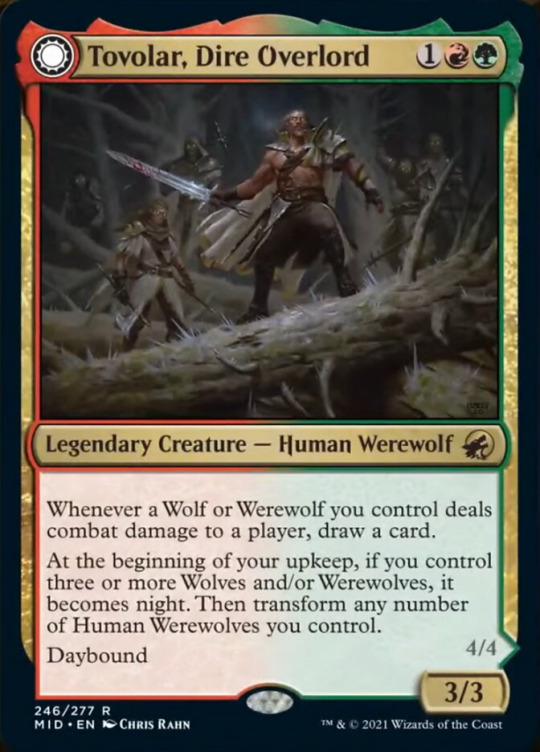
Unfortunately, despite the shiny new commander the deck has, I’m not confident that the many, many issues that make Werewolves awkward in Commander have actually found an answer.
Issue 1: The cardpool
Werewolves are kind of in this awkward place where due to mechanically being tied to Innistrad and its double-faced-card Transform mechanic, there just aren’t very many of them, even though we’ve been to Innistrad 3 times now. As well, of the current 6 Innistrad-based sets, 2 of them (DKA and EMN) are small sets and 1 (AVR) doesn’t actually have any werewolves in them. The number of werewolves, therefore, is not particularly big- at time of writing, 83 cards exist with the word Werewolf or Werewolves, and of those 5 are explicit hate pieces. And one is Victim of Night, a removal spell that happens not to hit them. That leaves 78 cards to work with, outside of Changelings.
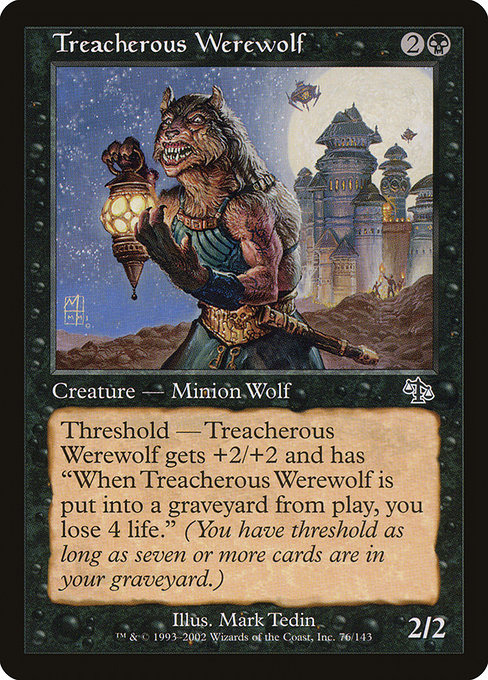
Frustratingly, WoTC has done very little to supplement this when visiting other planes. There exist exactly 6 Werewolf-related cards printed outside of Innistrad, with only 4 of those actually being Werewolves. I appreciate the slight bones being thrown in the form of WAR Arlinn, Nightpack Ambusher, and AFR’s own Werewolf Pack leader, but that’s about a card a year, which is not enough to support a tribe like this.
There’s also an issue where most of the Werewolf cards are pretty much just limited fodder. Of the 62 cards with the type Werewolf on them (again not including Changelings), I’d wager maybe 30 of them are playable in Commander, using an extremely loose definition of the word playable and with the understanding that this deck is going to be janky as hell. The tribe really suffers from its flavour-based limits, especially with the lack of non-Innistrad support, even though many of the game’s mechanics could be adapted to flavour of the Werewolf.
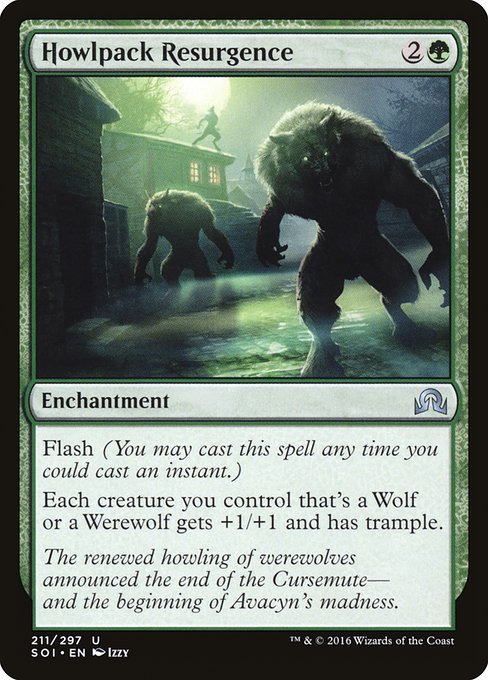
The final problem with the cardpool is the weak support cards. Werewolves have a fair few support cards, actually, but the issue is most of them are either not scaled for the format or only apply on one side of a 2-sided card. Many tribes in the middle-ground of card quality can get propped up by a handful of really good support cards- as an example, Treefolk have Timber Protector and Leaf-Crowned Elder, and Myr have Myr Galvaniser, Myr Turbine, and basically every Artifact support card ever to exist. Werewolves are stuck with, outside of one or two spicy new cards, mostly just +1/+1 anthems/counters and a handful of keywords, and also Immerwolf/Geier Reach Bandit (but the latter only half the time).
The result of this is that despite arguably being one of the better supported tribes as far as card numbers, Werewolves seriously pale in comparison to the majority of the field, especially compared to their Innistradi brethren- they look real awkward next to Humans, Zombies, Spirits, and Vampires.
Issue 2: The colours

Werewolves are pretty shoehorned into Gruul as far as the cards go. Both legendary Werewolves and the Werewolf Planeswalker are in the colour combination, as well as the vast majority of the tribe’s members. However, Midnight Hunt has added some other options in all 3 other colours, and there are reasons to run each anyway- mostly to do with, you know, that whole cardpool issue.
Because as good as Tovolar is, this tribe needs a little help from another colour, in my opinion.
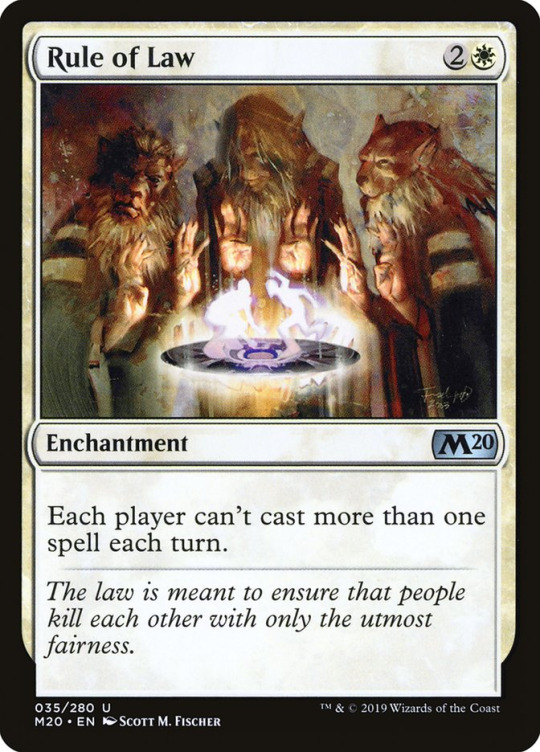
White is the most commonly added colour to Werewolf decks, due to getting to play Rule of Law effects to stop your Werewolves from getting flipped back over. If I build Werewolves, it probably will be Naya, just because I already have two Gruul decks, but my issue is the lack of a clear Commander. Samut is clearly the best option, mostly on account of Flash and the deck likely being fairly aggressive, but I have an issue with commanders, particularly Tribal commanders, not accurately representing the deck. But then, what am I supposed to go with? Anara/Bruse Tarl? Gahiji? Rin and Seri kinda work flavourfully, if you squint, but they do nothing for the gameplay of the deck. I probably would have to just get over it and play Samut, and maybe you should too.
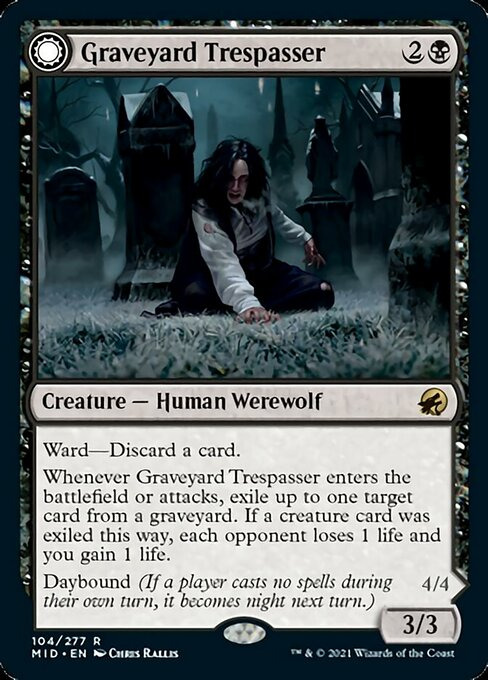
Midnight Hunt did also throw some Black Werewolves in, to go with the original 3 from back in the day (the utterly terrible Treacherous Werewolf, Lesser Werewolf, and Greater Werewolf), opening Jund as an option, kind of. My issue with this is that aside from just general good cards, Black doesn’t really add much to the deck’s likely plans, and only one of the new Black Werewolves, Graveyard Tresspasser, is really any good. I suppose this does mean you could run 4-colour with Saskia, but…eh…
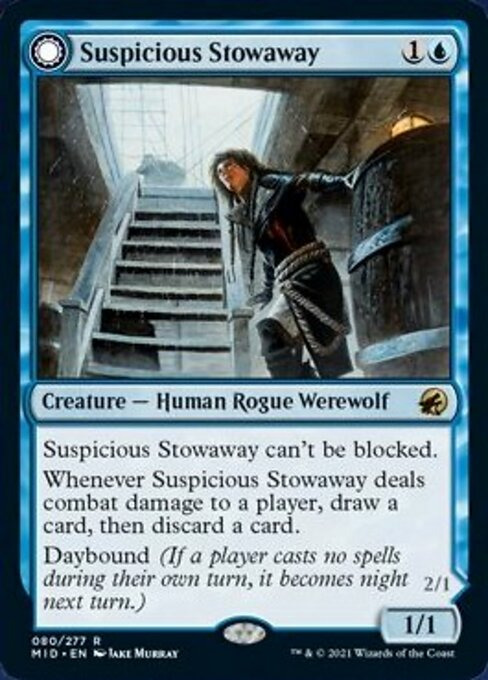
This set also added a singular Blue werewolf in Suspicious Stowaway, which is actually kinda okay. And also Blue gets one extra Rule of Law effect in Arcane Laboratory. But I don’t think I’m going to see Temur Werewolves anytime soon. I guess you could run Surrak? Blue does notably also get you a bunch of the better Changelings, on account of their recent Kaldheim iterations being in Green-Blue.
There is always, of course, Morophon. But that fucker’s for cowards. The TL;DR is, that Werewolves’s best commanders don’t give you access to everything the deck needs.
Issue 3: The tribes
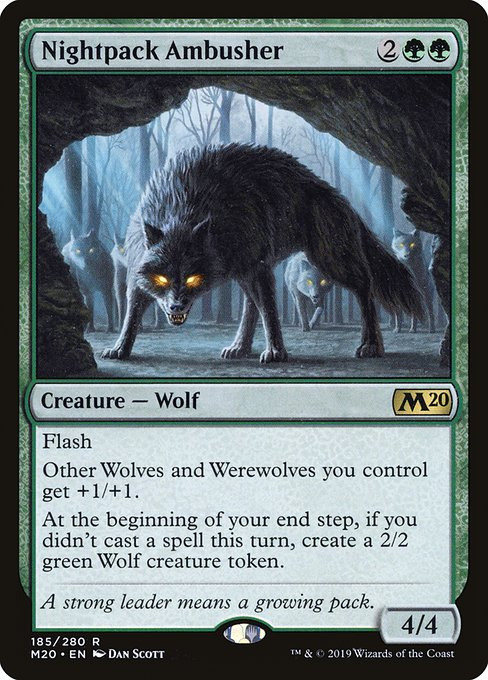
This is somewhat of a more minor issue, but one worth bringing up. Many of the Werewolf matters cards are shared with Wolf matters cards, and so it’s likely worth bringing a few of the better Wolves into the mix. Sarulf, if you’re including Black, or one or both Tolsimir-s in White. Wolves are a tribe with many, many more members, especially adding in all the Wolf Token producing cards, though there are still fewer Wolf Matters cards than Werewolf Matters ones. Also, some of the Werewolf Matters cards are Wolves, like Nightpack Ambusher, Silverfur Partisan, and Immerwolf. So there’s probably a fair few worth throwing in.
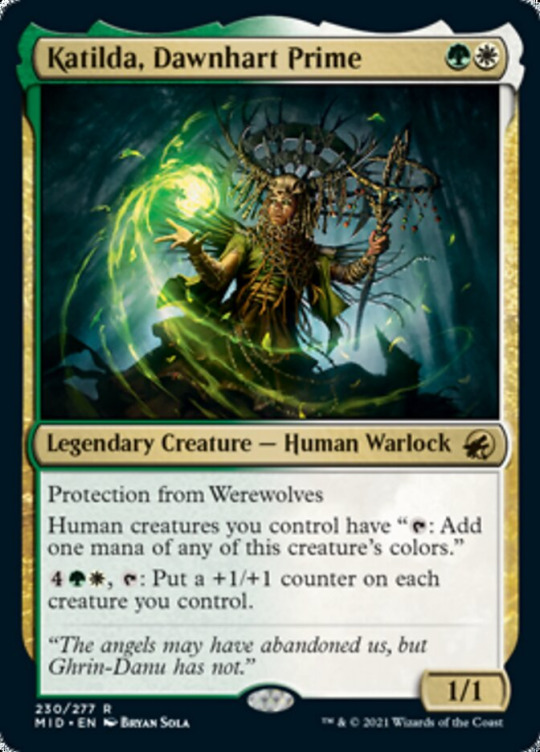
As well, seeing as the vast majority of Werewolves have Human front faces, some Humans matter cards like Angel of Glory’s Rise or the new Katilda are worth a shout. There are very few of these that work unfortunately, seeing as you are actively trying to have your humans not be humans, but it’s potentially worth the look.
The reason I find this to be an issue is that you can only add in so many subthemes like this before the deck’s real synergies start to get too heavily diluted. Every Wolf you add makes your Werewolves worse, you know?
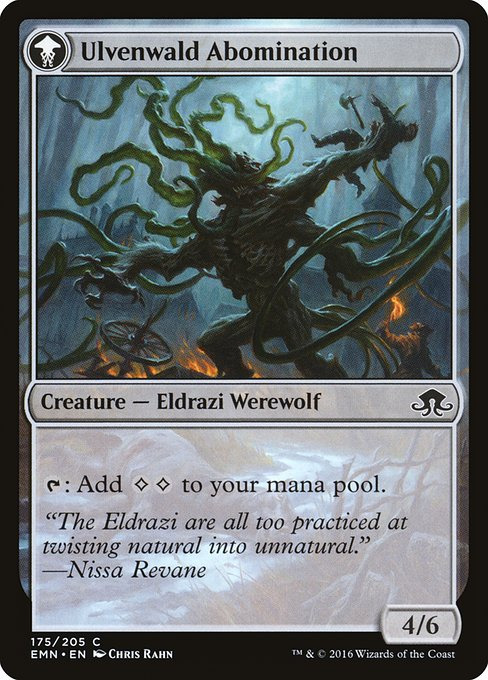
I dunno maybe this one was less an issue and more just a recommendation. And yes I know most of the non-Human Werewolves are in fact Eldrazi, but as much as I love those cards they’re both mostly bad and there’s not enough of them, so don’t bother putting Eldrazi cards in there. You have to dump a lot of mana to flip them anyway.
Issue 4: The gameplay
Werewolves as a tribe are extremely challenging from a gameplay perspective. You have to be paying close attention every turn, in order to make sure that you know when your Werewolves are transforming- and in a format like Commander, they are probably not spending nearly as much time with the back half as they are the front half.
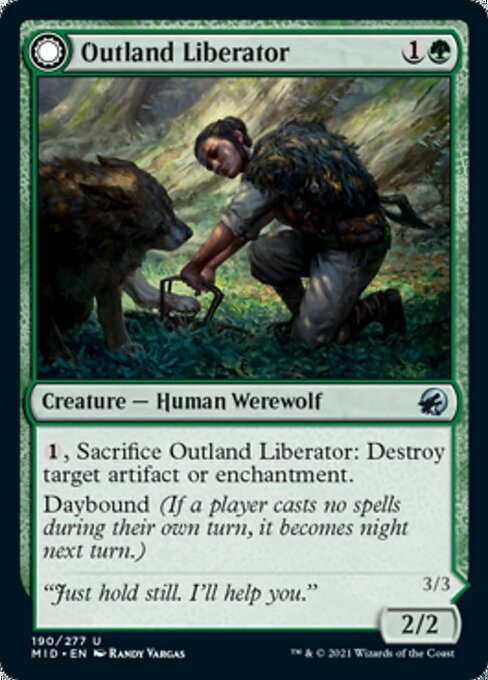
While I appreciate Midnight Hunt’s design efforts to simplify this with the Daybound mechanic, in Commander this kinda just makes it worse. Daybound means you are having to track this mechanic at all times, even when you or nobody else has a Werewolf on the field, as long as you’ve played one of the new ones beforehand. As well, the older cards (which you will need some of) are completely unlinked to this day/night cycle, even though they technically use the same trigger, which can lead to some confusion- if, for example, Tovolar makes it Night on your Upkeep, playing a Duskwatch Recruiter is still going to leave you with a Duskwatch Recruiter, not a Krallenhorde Howler.
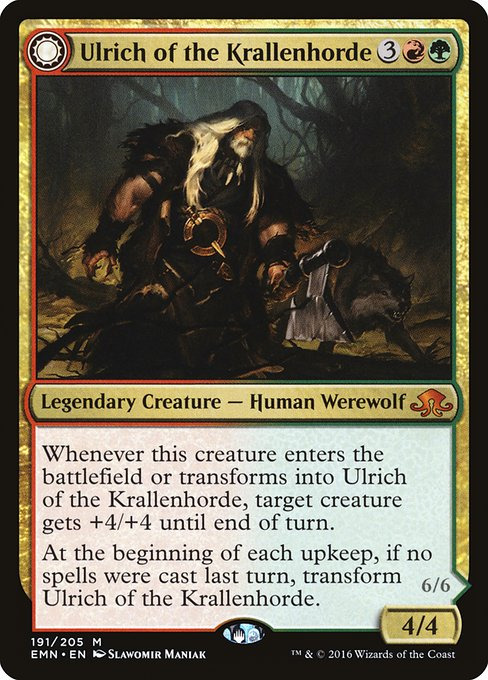
Considering Tovolar is likely the leader for most Werewolf decks going forward, I appreciate the effort to make him work with the Werewolves of the past, and that he tries to mitigate the tribe’s biggest issue. But there are a whole bunch of really finicky interactions that are both difficult to get your head around and difficult to explain to others when you pull them off. For example, if the player before you casts two spells on their turn, it becomes Day as the turn begins, meaning all your MID Werewolves will transform immediately, then Upkeep happens, and any of your non-MID Werewolves flip as well. Then Tovolar triggers, and you can transform as many of your Werewolves as you want- so if you stack the triggers right, then something like, say, Huntmaster of the Fells or Ulrich of the Krallenhorde will get to transform twice in the same step and get both of its “when ~ transforms” effects.
The other half of this is just the mental load on your opponents. You know what all your cards do, but your opponents aren’t going to! And this is a typical thing in EDH, the game requires either a massive knowledge of Magic, an ability to pick up on new cards and interactions quickly, or both, but it gets so much worse when each of your cards has two sides worth of text to read off whenever you play one. And people (particularly those with less-than-perfect threat assessment) are going to typically assume that the more words on your cards the better they are, so you might get targeted just based on that even though half the words aren’t relevant most of the time.
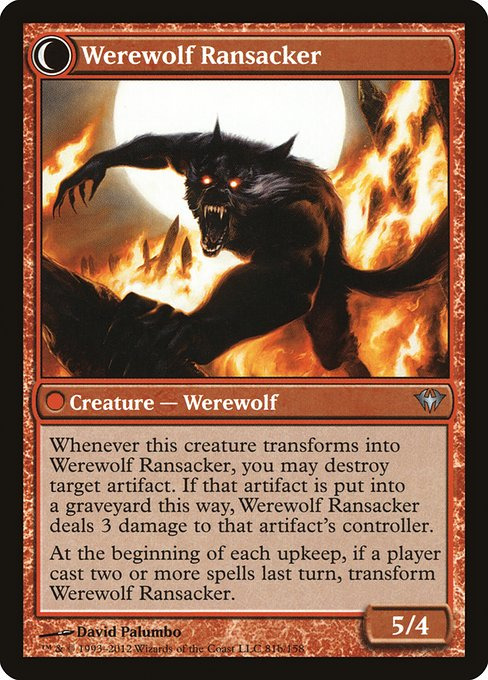
The long and short of Werewolves in EDH is this: They’re still awkward and janky. I think you can actually build a deck, but you could already do that technically, and I think the additions from MID aren’t quite enough to bump the tribe up to Actually Good. They are, though, about the level of Jank that I appreciate, so maybe I’ll still just build them anyway.
There is potential hope, though. Innistrad: Midnight Hunt is an Innistrad Werewolf Set that contains no less than 15 Vampires (one of my biggest issues with the set!), and the next set is Innistrad: Crimson Vow, the Innistrad Vampire Set. Due to the mechanical requirements, I can’t imagine we’re seeing 15 Werewolves in that one, but I’m hoping we do at least get a couple extras. And hey, maybe one of that one’s Commander decks will be Werewolves!
…The previous was written under the assumption that we didn’t know what the VOW Commander Decks were. As it turns out, we have the names. Neither of them are Werewolf themed.
God damn it, maybe next time we come back to Innistrad then. So, see you in 2026.
22 notes
·
View notes
Note
I’m obviously late to the tumble party... but I stumbled across your Notagami Essays posts and they are absolutely Fabulous! Love your writing and the amount of detail you go into :)
So I figured you may be a good person to ask - if you just had to guess (bc as far as I know it’s never been officially confirmed?) but if you had to take a guess or give a rough estimate, how old do you think Yato was when he first met Sakura? We know he’s estimated to be at least a thousand years old, we know he’s - from the start of the series to present - estimated to be somewhere between 18 and his early 20s (physically)... but I can’t find a single thing/discussion/post/stickynote/whatever where it talks about how old he might have been when he first met Sakura - let alone the emotional/psychological effects of Sakura coming into his life and introducing healthy mindset/morals/maternal-influence etc. etc. (obviously no mom and Father’s neglect played a big role in him not knowing how inappropriate it was for him to ‘accidentally touch’ and yell “boobs!” but you can also just say he was so young he didn’t know how inappropriate that was?) My point is: how old do you think Yato was (physically anyway) at the time of their meeting? and Do you know of any discussions or care to share your opinion on how being the no more than the age of blank affected his mental/emotional understanding of Sakura teaching him a new narrative?
Sorry this is a random out of the blue ask 😅😓 if I rambled on and you don’t feel like answering, I get it, just figured it was worth asking :)
I fell down a serious rabbit hole trying to see if I could figure out the answer to this question about Yato’s age but unfortunately I’m mostly coming up empty-handed.
The answer to this question actually depends on two different pieces of information which--as far as I can remember--we’ve never actually been given for certain.
1) We would need to know when Yato was actually born.
The manga has kind of hinted at a total (not physical) age for Yato in the flashbacks which showed him as a young child during the Heian era (putting him somewhere in the vicinity of a little over 1000 years old) and Father not making masks before ~1100 years ago, but the problem is we still don’t know how many years might have passed between this scene (the youngest we’ve ever seen Yato):

And the next flashback scene, where Yato meets Nora:
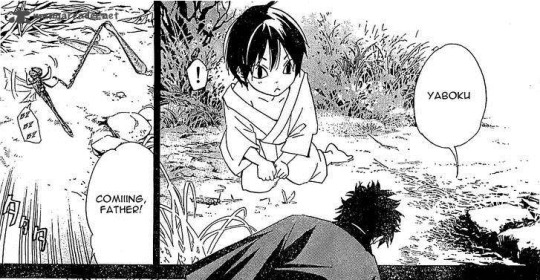
If gods age normally when they are children, these two scenes might be only a handful of years apart. But if gods don’t age normally, then these two scenes could be decades or centuries apart, which leads to the other missing piece of information (under the read more to save people’s dashes):
2) We would need to know the aging process for gods who are just born/reincarnate.
Up to this point in the manga, we’ve only seen two gods reincarnate--Ebisu (who reincarnated too recently to really help answer this question) and Takemikazuchi. The implication of Takemikazuchi’s backstory is that his shinki forced him to reincarnate and then hid his reincarnation from all of Heaven. The only way they could have kept other gods from noticing that Takemikazuchi had reincarnated would have been by not allowing him to go out at all until he had grown enough to match his previous reincarnation in appearance. This seems to suggest that gods probably do age normally when they are children--hiding Takemikazuchi away for ~20 years seems a lot more likely than being able to hide him away for centuries, after all... (I also feel like I have very vague recollection of some scene in the manga where someone comments on Takemikazuchi not having been around for a “few years,” but it’s been so long since I reread I can’t recall if this is a real moment from the manga or just me misremembering.)
Overall, however, based on what we’ve seen in the manga, my guess would be that when they’re young, after just being born or being reincarnated, gods age pretty normally. This would suggest that, for the first few years at least, the physical and mental ages of reincarnated/newly born gods actually overlap; baby Ebisu acts like a little kid because he is, in fact, both mentally and physically a little kid.
That would mean that, for all intents and purposes, Yato’s physical and mental ages lined up when he was young and meeting Sakura, and he acted like a little kid because he really was just a little kid, god or not.
(Detour for a second though:
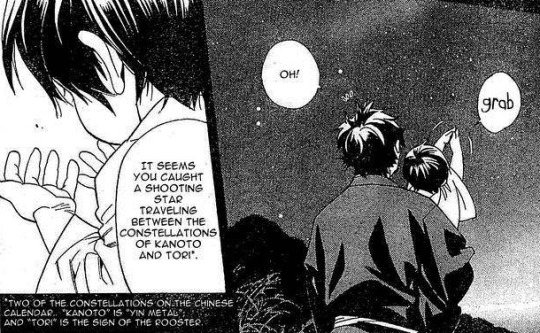
This line always struck me as interesting in that it might, just might, give us a more specific timeframe for Yato’s “birth”: although the constellations, of course, are visible in the sky every single year, this particular combination of concepts (kanoto-tori, yin metal rooster) is known much more commonly as one of the sixty years on the cyclical Chinese calendar, also used in Japan. Counting back on the calendar, 961 A.D. was a yin metal rooster year and would align just about right for what we know about the timeframe in which Yato later met Sakura (~970ish). Just referencing constellations doesn’t mean Adachitoka was pointing to a specific year, but it might have been another hint as to the timeframe of the flashbacks.
Okay, detour over.)
Anyway, without 100% confirmation on either of those pieces of information--when Yato was born and whether gods age at the same rate as humans after reincarnating--I don’t think it’s really possible to pin down Yato’s “real” age (physically or mentally) at the time he met Sakura. We mostly just have to estimate.
Personally, based on his size and behavior at the time, I’d put him somewhere between seven and maybe up to ten, but the way Adachitoka draws characters kind of makes it impossible to judge their ages by appearance; Yato is about the same size as Nora when he meets Sakura, implying that he and Nora were around the same physical “age” at that time; meanwhile, Nora is later portrayed as being roughly the same age as Yukine, suggesting she was maybe 12-13ish years old when she died. So, despite being drawn tiny, it’s possible Yato was meant to be anywhere from a little kiddo (6-7) to all the way up to Nora’s age by the time he met Sakura.
But all that said, I think what you were really asking about was more the mental state Yato would have been in when he met Sakura and how his young age would have impacted his ability to change his world views, right? The answer to that is... complicated and could be approached a lot of ways. Coming from a background of working with and educating social work students, there are several common psychological theories of child development that might apply here, for example.
I’d recommend checking out Erik Erikson’s psychosocial stages of development, though.
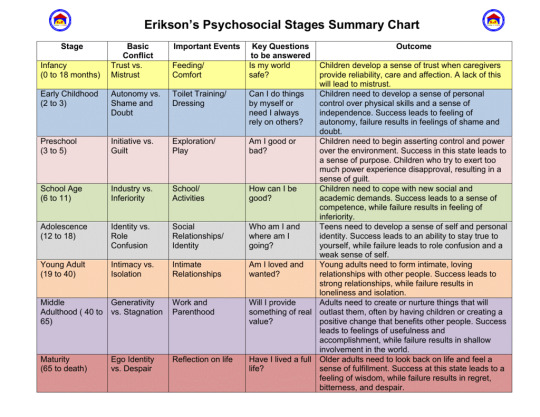
(Pulled from here.)
I don’t have time to explain the entire theory with the complexity it might deserve, but the basic idea is that, as children develop, they experience a series of crises or challenges that they must overcome. Successfully overcoming each challenge results in successful psychological and social development; failing to overcome a challenge in childhood will result in long-term negative impacts later in the child’s life. (There are plenty critiques of this theory too, so don’t take this as gospel or anything--just a theory worth thinking about!)
Given Father’s lack of interest in teaching Yato basic concepts of humanity, I would put Yato at approximately the “Initiative vs. Guilt” stage when he met Sakura. At this level of Erikson’s theory, children struggle with asserting themselves and developing a healthy sense of how their personal desires might conflict with the expectations and rules set out by others. In this stage, giving a child positive feedback for their actions teaches the child that those actions are “right,” while giving negative feedback teaching the child that their actions are wrong. In order to overcome this particular challenge, children need to begin taking initiative and aligning their actions with social standards; the child acts, and the parental figure reacts--through this process, children learn “I can do X thing but I cannot do Y thing.”
When you hear things like “Children are cruel,” most often what people are referring to is that it takes time for children to learn empathy and to experience guilt when they cause harm to others; children do not natively understand the repercussions of their actions. It’s only through a process of testing the boundaries, of receiving praise or punishment, that children define what is “right” versus “wrong,” and begin to feel bad when they do something deemed wrong.
And this is pretty much word-for-word what we see Sakura teaching Yato.
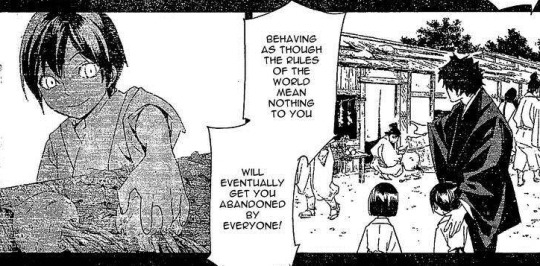

If they have healthy role models and caretakers during this phase, children develop successfully. Successful children in this phase get their first taste of personal responsibility; unsuccessful children are (supposedly) plagued for years afterward by a sense of guilt and shame when their actions produce disapproval from everyone around them.
Yato... doesn’t exactly make it through this development stage unscathed, because he receives conflicting definitions of right and wrong from his Father an Sakura:
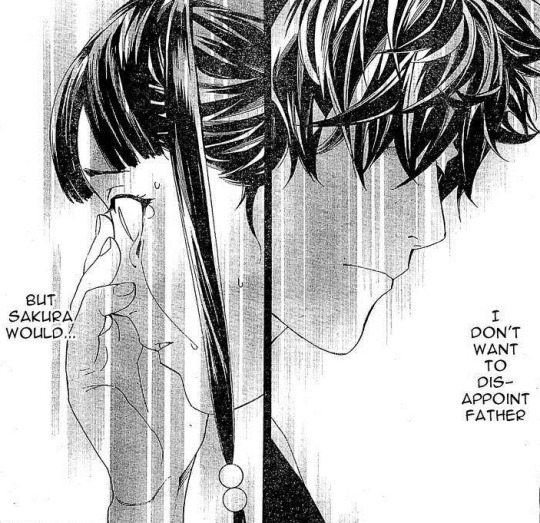
Which ultimately results in, years later, the Yato we know and love who still does his Father’s bidding to kill humans even though it fills him with a horrific sense of guilt:
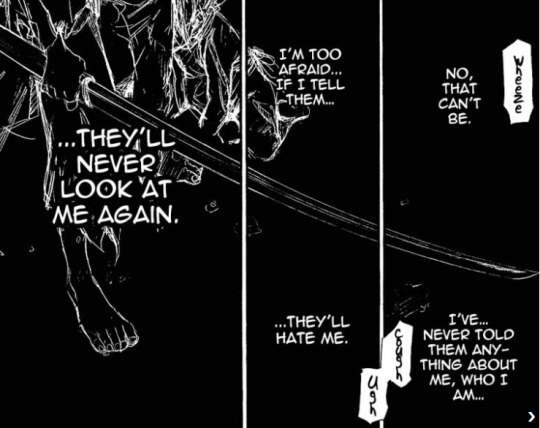
Through his time with Sakura, I think it could also be argued that Yato moves into the next stage of Erikson’s theory as well, getting into the “Industry versus Inferiority” crises.
Meeting Sakura brings out Yato’s true, deep down desire as a god: to help people. (I think it’s important to note that this isn’t something Sakura teaches him--it’s a quality Yato already possessed; it was explicitly Yato’s desire to please people that led to him murdering in his father’s name.)
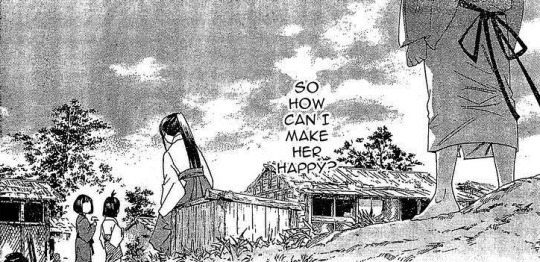
Once he learns what makes people happy, Yato immediately pursues that with intense focus:

The primary goal of this phase of psychosocial development is to experience a sense of confidence in one’s actions. When children practice their skills, pursue areas where they are praised, and gain new skills and aptitudes through mentoring from healthy role models, they gain confidence in their ability to excel, to fit in with peers their age, and to create meaningful things. By encouraging Yato to pursue positive behaviors--playing peacefully with other children, appreciating natural beauty, and creating useful things like boots for the needy--Sakura moved Yato toward successfully completing this phase and developing a sense of confidence in his actions and his ability to achieve positive things in the world.
Of course, Father cannot have that (because confident children with a sense of self-worth are much more difficult to abuse), so he puts an immediate end to Sakura’s influence over Yato in the most insidious way possible: although he clearly manipulated the situation to achieve Sakura’s death, out loud, he blames Yato, implying that Sakura’s death was all Yato’s fault, the results of Yato taking unwanted action “industry” and yet failing--creating a sense of “inferiority” instead.

This, of course, haunts Yato all the way to the present, as he--again and again and again--blames himself for things outside his control or failing to live up to expectations that no one in his situation (still being manipulated) could possibly hope to get “right.”
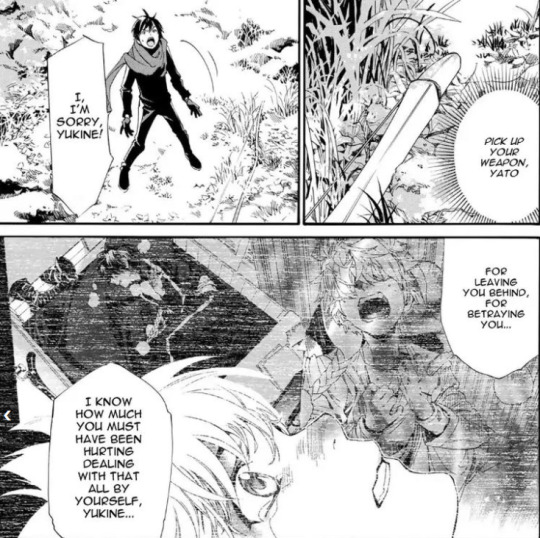
Finally, you could say that Sakura’s presence is Yato’s life is ultimately what sows the seeds of the manga’s main plot up to this point, with Yato’s quest to create an entirely new identity for himself as a god of fortune instead of a god of calamity. Personally, I would say that Yato is currently still in this phase of development, still working out how to define himself and who he will ultimately become once he is finally free to decide on his own path in life. It was Sakura’s gentle influence--his desire to become the kind of god who could make her smile--that eventually sparked his conflict and finally led Yato to the brink of catastrophe. If he wishes to become the god Sakura told him he could be, he can no longer suffer his father to live.
So, long story longer, I think it can be argued that Yato meeting Sakura at such a young age is EXACTLY what made it possible for him to change, and exactly what has led to his crisis in identifying himself and redefining his sense of right and wrong.
Uhhhh... I hope that answers your question!
#noragami#noragami meta#noragami spoilers#noragami manga#psychosocial development#Yato#Sakura#Father (Noragami)#speculation
92 notes
·
View notes
Note
How do you think Barok would react to realizing that he's in love with a working class person? Given that he's rather blunt about his dislike of the "vulgar class", I imagine that there'd be some internal conflict on his end.
Headcanons (Classism)
Notes: Good question, anon! Before I get to the character headcanons I will make a few general points about class / status in the Victorian Era -- but I'll try to avoid it becoming too dry!
Content Warnings: Historians... please don't look; Classism; Tia butchers history... again.
A few important terms:
Noble ('the nobility'): those who hold 'titles' ('Duke', 'Baron', etc) that have been passed down through their bloodline. Not all nobles possess the wealth that one might expect them to, but they do hold prestigious titles and their families are often well-respected (which makes marrying into such families attractive to those with wealth but no social standing).
Aristocrat ('the aristocracy'): the term aristocracy literally means 'rule by the best', and that has typically come to mean the wealthy (because wealth gives access to better opportunities, such as education, and influence, often political or military). Not every member of the aristocracy is a noble, but all nobles are deemed to be aristocrats.
Middle Class (aka 'the Bourgeoisie'): is a category that grew rapidly in the Victorian era due to the expansion of cities and the economy. They were people who worked skilled jobs in order to support their families, e.g. merchants or 'white collar professionals' (doctors, lawyers, etc).
Working Class: people who were uneducated and unskilled. They were perceived to have nothing to offer society, save for their labour. Most working class people lived in abhorrent conditions and were horribly exploited.
There were three umbrella terms for the 'classes' of people in Victorian times: (1) the Upper Class; (2) the Middle Class; & (3) the Lower Class. To make things even more confusing, the Upper Class was further subdivided into: Royalty; 'Middle Upper' (important officers / lords) and 'Lower Upper' (wealthy men and business owners); while the Middle Class was divided into 'Higher Level' and 'Lower Level', with the lower Middle Class working for the higher Middle Class.
Finally, there was a class deemed lower than Working Class: the 'Under Class', this was comprised of the helpless / those who depended on others to survive (e.g. orphans).
──────≪⊰✥⊱≫───────
General points:
The Victorian era was an interesting time in terms of class, because the 'ruling' class (i.e. the nobility) was becoming increasingly impoverished while 'commoner' merchants and entrepreneurs were amassing vast amounts of wealth. These people then looked to acquire status by marrying members of the nobility.
It became increasingly ordinary for nobles to marry into wealthy 'commoner' families in an exchange of status for financial security.
Note that the term 'commoner' at this time was not synonymous with the working class, it was a person who lacked a title.
So although noblemen and women would marry 'commoners', and that practice would becoming increasingly accepted as the wealth amassed by the ancestors of noble families dwindled, the notion of a noble marrying a person of working class was completely unheard of.
In short, nobles and working class people existed in circles that were so separate from one another that the idea of them meeting was inconceivable let alone a noble 'debasing' themself by marrying a person without education, skill or means.
At first, merely marrying a commoner was enough for a nobleman or woman to be ostracised from their aristocratic family but as I've mentioned above: this became an increasingly common practice among the nobility as they sought wealth rather than holding on to lofty principles of keeping bloodlines 'pure' (sadly such thinking was a commonly accepted notion in the past, hence why people cared so much about the standing of families / potential spouses).
──────≪⊰✥⊱≫───────
Character points:
So, if I were to go 'full Victorian' then no matter how much Barok might have loved someone of working class, it's unlikely that he would have married them (it's also questionable about what kind of common ground they would find together if his partner was uneducated and unskilled).
Therefore, I'm going to depart from the strict notions of class that existed in Victorian England and think more in terms of Capcom's far softer world -- where even a working class (or even an 'Under Class' person, like Gina) could have access to opportunities to develop skills and thus practise a profession.
Personally, I've always taken Barok's reference to the 'vulgar classes' to be somewhat tongue in cheek. It feels more to me like him insulting the tastes of those he disagrees with (e.g. questioning their interest in literature rather than their actual standing).
Regardless, I believe that as he becomes a more open-minded individual he would start to see things such as class and standing as superfluous when compared to meaningful connections.
After all, what good was his title once Klint was dead? What does a title matter when so many aristocrats are more rotten than the majority of British people? By the end of GAA, I think he'd see his title as a meaningless word. So what if he comes from a noble family?
Does he conduct himself in a noble manner? Does he act with honour? That's what really matters. In the same vein, his partner's status would come to be irrelevant: it's the quality of their character and the strength of feeling that he holds for that that important to him.
Of course, he knows others might gossip and he would worry about the way in which his beloved might be treated by the members of the aristocracy (because they will almost certainly fixate upon the 'peasant' and be generally unpleasant) -- but from his perspective, he loves them and that's all that matters.
18 notes
·
View notes
Note
Do you like Lindsay Ellis? Even though her points on Sansa and Dany were completely off? She basically bashed Sansa and defended Dany treating her like an actual hero. That’s just wrong.
I haven’t heard of her until her name started to pop up on my dash because of her “hot takes”, especially on Sansa. So, to give you a proper answer, I went and watched her video. And, oh boy...
You may take this as a counter-argument to hers. I’ll take her approach; first I’ll speak about power citing Important People™, and then I’ll head straight to the rebuttals. (You may skip the philosophy lecture if you want. I’ll actually use it to justify my answers, so, it’s up to you. In case you don’t want to read the whole thing - which is totally understandable and, you know what, even recommend - I’ve put the key points at the end of first part of this meta.)
She starts the video talking about the nature of power, quoting the writer Robert A. Caro:
“We’re taught Lord Acton’s axiom: all power corrupts, absolute power corrupts absolutely [...]. I believed that when I started these books (about Lyndon B. Johnson), but I don’t believe it’s always true anymore. [...] What I believe is always true about power is that power reveals. When you have enough power to do what you always wanted to do, then you get to see what the guy always wanted to do”.
Let’s take a second to analyze this. First off, it starts with a quote that GRRM likes to go back to a lot. After all, ASOIAF is a work of (fantasy) fiction that analyzes the nature of power and its dynamics and just how much it can corrupt a person, even those with good intentions. That’s the core of GRRM’s work, the nature of power and what it can do to a person.
I agree with Caro when he says that power reveals, but power does not only reveals what a person wants to do, but how that person does that. The how is just as important as the what, especially when we’re talking about political figures (fictional or not).
(I talked about Daenerys and what is it that she does with her power in a couple of metas - some are mine, the others are from awesome people in which case I’m just putting my two cents on the matter - : X, X, X, X, X)
There’s a very interesting conversation between Michel Foucault and Gilles Deleuze, called “Intellectuals and power”. Here are some excerpts that I believe are important when talking about the nature of power:
M. Foucault: [while talking about the prison system and can power be found its raw form in prisons] What is fascinating about prisons is that, for once, power doesn’t hide or mask itself; it reveals itself as tyranny pursued into the tiniest details; it is cynical and at the same time pure and entirely “justified”, because its practice can be totally formulated within the framework of morality. Its brutal tyranny consequently appears as the serene domination of Good over Evil, of order versus disorder.
What Foucault is that we can find power (in this particular case, in prisons) that is tyrannical but, at the same time, manages to justify its ruthlessness, all because it was built in a framework that enables it to do so. So, we can see people punishing other people, sometimes in the most brutal of ways, all in the name of morality: because Evil must be punished by Good, as to set an example that Good will always dominate over Evil.
M. Foucault: [about the nature of power] (Power) is at once visible and invisible, present and hidden, unbiquitous. [...] The question of power remains a total enigma. Who exercises power? [...] We now know with reasonable certainty who exploits others, who recieves the profits, which people are involved [...] But as for power... We know that it is not in the hands of those who govern. [...] Everywhere that power exists, it is being exercised. No one, strictly speaking, has an official right to power; and yet it is always exerted in a particular direction, with some people on one side and some on the other. It is often difficult to say who holds power in a precise sense, but it is easy to see who lacks power”.
In this excerpt, in which Foucault disscuses the nature of power and how it works, I’d like to highlight two sentences; the first one being “Everywhere that power exists, it is being exercised” and the second being “ [...] It is easy to see who lacks power”.
Regarding the first sentence, it shows power as something that is always active; there’s always someone with power, using that power. There is a person/group regarded as the powerful. But given the dual nature of power (visible/invisible,present/hidden), if there’s the powerful, then there’s also the powerless. And that’s where the struggle appears. Because power is a force with no master, yet it seems someone/some specific group has it. So, there’s always a struggle to obtain power.
Regarding the second sentence, Foucault distinguishes that the most recognizable characteristic about power are the powerless. When you have something that can hide and disguise itself, which is the case with power, then it’s clear that it’s easier to spot those who lack that something. That’s why when trying to understand power dynamics, we always talk about things like “true power”, “the person behind the curtain/calling the shots”, etc., but we don’t have phrases like that regarding those who lack power. The powerless are just that: people who lack power. Powerlessness doesn’t hide to the eye, it’s always present in its true form, unlike power itself.
G. Deleuze: [...] How is it that people whose interests are not being served can strictly support the existing power structure by demanding a piece of the action? Perhaps, this is because in terms of investments, [...] there are investments of desire that function in a more profound way and diffuse manner than our interests dictate. But of course, we never desire against our interests, because interest always follows and finds itself where desire has placed it.
Here, Deleuze presents an intriguing thought. How is it that people that have no power support a system that won’t change their situation (in relation with power) and still be active in said system? Deleuze argues that desire weights more than interests when it comes to the powerless; so, when driven by desire, people act according to them. But there is something that’s worth keeping in mind: whether be powerless or powerful, people never desire against their interests, because desire can act as a tool to protect those interests.
TL;DR:
Power can be tyrannical while disguising itself as being moral, all because it exists in a framework that allows it to do so. With this kind of power, ruthlessness is justified as Good dominating Evil.
Where there’s power, there’s always a person/group exercising said power, even though power belongs to no one. So, with the exercise of power, comes the making of two distinct groups: the powerful and the powerless; both groups then struggle to control that power: the powerless fight to gain power, the powerful fight to keep their power.
Powerlessness doesn’t disguise itself. It’s easy to recognize. So, the powerless appear just as they are, they have no reason (or means) to disguise their true nature.
Sometimes desire can weight more than interests, but people never desire against their own interests.
So that’s that on (some of) the philosophy of power. Now, let’s get into the what you asked, nonny.
I’ll start with the things that I agree with.
Problems with characterization
I think we can all agree on one single fact: D&D (and the entirety of the writer’s room) downplayed the characters’ defining traits in order for them to fit within the plot/drive the narrative forward. This is something that started around S5, when D&D ran out of books to adapt. So, the problem D&D were presented with at that time is that they knew the endgame to all the core characters, but had no step-by-step guide to help them reach said endgame.
Flash-forward to S8, and we’re in the middle of a whole mess. We get to certain plot-points, but we reach those by the way of the narrative explaining us how the characters or the story gets there, instead of the characters reaching those plot-points organically. The characters’ endgame is treated more as a destination (somewhere we must reach) and less as something that would wrap up the characters’ arcs in an organic* way.
* By organic, I mean that we (the audience) see the characters make certain choices (or not), say things (or not) that will eventually lead them to their endgame. A story like Thrones is character-driven, it always was. It was the decisions these characters made that had a ripple effect on the storyline, either personal or political (or both). By season 7, and more explicitly in season 8, the storyline was driven by plot-points, so it was not the characters influencing the story, but the story influencing the characters acted
So, what we end up with is various examples of “tell, don’t show”, which really is a sin in storytelling, especially in a visual medium. That’s why a lot of people weren’t sold by Jonerice, because it was so easy to spot the “lie”.
Now, time for the counter-arguments! (I’ll focus on some of the “arguments” she makes that stood up for me).
“Sansa has no pathos”
Well, that’s actually true. First, let’s start with some definitions of pathos:
Pathos is a quality of an experience in life, or a work of art, that stirs up emotions of pity, sympathy, and sorrow. Pathos can be expressed through words, pictures, or even with gestures of the body.
Pathos is an important tool of persuasion in arguments. Pathos is a method of convincing people with an argument drawn out through an emotional response.
Emotional appeal can be accomplished in many ways, such as the following:
-by a metaphor or storytelling, commonly known as a hook;
-by passion in the delivery of the speech or writing, as determined by the audience; and
-by personal anecdote.
One of the characters in GOT/ASOIAF that appeals to the emotion of others (uses pathos in their rethoric) is Daenerys. I’ve written a little thing about it here
Sansa, instead, uses ethos in her arguments. That’s how she appeals to people. But, what is ethos?
Ethos represents credibility, or an ethical appeal, which involves persuasion by the character involved. [...] The credibility of a speaker or a writer relies on his or her authority on the subject matter, as well as on how much he or she is liked and deemed worthy of respect.
Ethos forms the root of ethikos (ἠθικός), meaning "moral, showing moral character"
Speakers must establish ethos from the start. This can involve "moral competence" only; Aristotle, however, broadens the concept to include expertise and knowledge. Ethos is limited, in his view, by what the speaker says. Others, however, contend that a speaker's ethos extends to and is shaped by the overall moral character and history of the speaker—that is, what people think of his or her character before the speech has even begun.
For Aristotle, a speaker's ethos was a rhetorical strategy employed by an orator whose purpose was to "inspire trust in his audience" (Rhetorica 1380). Ethos was therefore achieved through the orator's "good sense, good moral character, and goodwill", and central to Aristotelian virtue ethics was the notion that this "good moral character" was increased in virtuous degree by habit (Rhetorica 1380).
Lindsay Ellis refers to pathos (or the lack-of) in Sansa’s arc meaning that she’s never shown to emotionally process what she’s been through. But if we were to properly use the word pathos, Sansa never appeals to us, the audience, in an emotional way. That’s her criticism. And it’s fine, but there’s something she’s missing while making this criticism: all of Sansa’s storylines were based around other characters, oftentimes male characters. Sansa has never been at the center of her own narrative, unlike Daenerys.
“New Empowerment Sansa spends the whole battle trash-talking Daenerys, who, unlike Sansa, is out there risking her life”
(I’ll do this one in parts because there’s a lot to unpack here)
First of all, it’s not trash-talking if it’s true. As I pointed out before with the conversation between Foucault and Deleuze, there are two things to keep in mind regarding the Sansa-Daenerys clash in S8:
“Everywhere that power exists, it is being exercised”; and
“We never desire against our interests, because interest always follows and finds itself where desire has placed it.”
The struggle between Sansa and Daenerys is political, they both seek to have power over a specific territory (the North). That’s their interest and their desire. It’s Sansa’s desire to keep Northern Independence and it’s in her best interests (and those of her people). Sansa’s desire and interests clashes with Daenerys’, since having the largest region of the Seven Kingdoms to remain independence goes against her interests (and desires) as a Conqueror.
Secondly, the living only had a fighting chance because of all the efforts made by the northerners and the KOTV, all under Sansa’s leadership as Lady of Winterfell. In S7, most of the northern lords were ready to jump out of the USS Jon Snow, but it’s because of Sansa’s leadership skills that the North remained a united front. The people fighting outside Winterfell were vital in the Battle of WF, but so were the efforts of the people tasked with assembling the barracks with dragonglass, the people putting leather on the armours, the men forging dragonglass weapons, the people tasked with feeding the soldiers and the refugees from all parts of the North. All of that was possible because of Sansa.
“New Empowerment Sansa won’t shut the fuck up about how much she doesn’t like Daenerys”
Seeing Sansa express her discontent with Daenerys is actually good, especially when you remember that she has been surrounded by enemies basically by the entire run of the show. That means she always had to keep her true feelings to herself, relying on very few people (trust issues are a big thing in Sansa’s overall arc). Sansa voicing her opinions shows us, the audience, she’s finally at a place in the story in which she finally feels safe to do so.
“Sansa’s evolution mirrors the Starks as a whole. The compassion and nobility that defined the Starks is one of their biggest assets, but in the end, they’re no better than the fucking Lannisters”
Ok, here’s the thing. Time and time again, we had different characters tell us, the audience, that northerners are loyal to their own, that they’re distrustful of outsiders (there’s a reason why “The North remembers” is basically their cathphrase). We’ve seen it with Robb, Cat, Sansa and Jon.
If one had to single out a theme for S8 (something weird to do, since D&D don’t believe in themes, but themes are present in every single story, whether you believe in them or not), the theme could very well be survival. At this point, everyone’s looking after their own. All those that made it this far had been through so damn much, have seen so damn much, that what they all want is to survive.
People have this misconception about the Starks: they’re this very good, very noble group of people. That’s true; if you talk about how the Starks are with the people they love and trust. And we’ve seen that trust issues are a big thing for the remaining Starklings. Ever since the start of the show, all of the Starks were separated: you had Ned with Sansa and Arya in the South; Cat with Robb, Bran and Rickon in WF; and Jon at the Wall. As the story moves forward, the Starkling find themselves alone; it’s all so they can learn to fend for themselves and once they reunite, act like a Pack of Wolves, each with a particular skill. From the beginning, the Starks were the one family that was beaten time and time again, only to get up and get beat one more time. People talk about the Starks acting like the Lannisters in S8 because we, as an audience, never had the chance to watch them act as a unit. And is it really so surprising to watch a family taking care of each other when every single person in the show is doing the exact same thing?
The Starks, for the first time since reuniting, are acting like a Pack. Like Old Papa Stark used to say: the lone wolf dies, but the pack survives. The Starklings are after survival, just like everyone else. The difference with, let’s say, northman #3 is that the Starks are aware of the political struggle in the near future with Daenerys and what that political struggle means fro everybody. Take S8E4 as an example. Tension is growing between the Starks and Daenerys. We, the audience, know that. Northman #3 doesn’t.
Going back to the subject of power, it’s really noteworthy how the powerful players use their power regarding others:
We see Sansa put the food issue on the table
(an issue no one seems to worry about or even remember, not even the writers).
She insists for the gates to remain open until the last northerner arrives for shelter. She is constantly fighting for the freedom of her people
(the northerners chose Robb as KITN, then chose Jon).
She also uses her power as Lady of Winterfell to protect her family
.
She tells Tyrion about RLJ not because she wants to cause trouble, but because she knows if the truth gets out, Daenerys won’t be able to hurt Jon
while they’re in the South.Since it’s difficult to make a clear reading of Jon’s arc in S8 (
since D&D butchered his character
), this will be more of an assumption. What
I
get from Jon in S8 is
Sacrificial!Jon
.
He does whatever he has to do to secure the alliance with Daenerys and to protect his family
. Ride a dragon? He’ll do it. Try to ease her temper regarding his family, namely Sansa? He’ll try his damnest. Tell her she’s his queen and that he loves her? A thousand times. Ride South to help her get the Iron Throne? Well... that didn’t go as he has hoped. What I’m trying to say is that
Jon tried to manage the situation at hand with the little power he had
(and he had
very little
power).
What we see is Jon trying and failing, and ultimately, he has this huge dilemma presented in front of him
: kill Daenerys and save the Starks; or let Daenerys roam free, knowing she will most likely burn Sansa (and all of those she feels like it) for treason? But the answer to this dilemma has been there since the beginning.
Jon Snow fights for the North. All his life, he wanted to be a Stark
. We know what happened next.
Ned says something that captures the essence of the Starks:
Ned: (to Arya) You’re a Stark of Winterfell, you know our words. (Winter Is Coming) You were born in the Long Summer, you’ve never known anything else but now Winter is truly coming, and in the winter we must protect ourselves, look after one another.
“So Sansa is a northern separatist now for some fucking reason even though now is not the time”
Sansa has been “a northern separatist” since this moment:
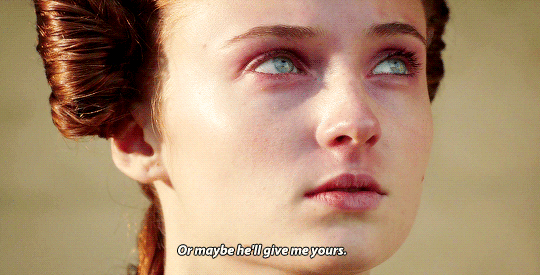
She’s been a central part of the Northern Independence plot. In case some of you don’t remember, Joffrey used to command his Kingsguards to beat her every time Robb won a battle (which was pretty much all the time).
The Red Wedding only intensifies her desire to go home and rebuild it (RE: Northern Independence). S5 happens (let’s leave it at that). In S6, we see Sansa reclaim her identity as a Stark, leading her House alongside Jon and fight for the North, for her people. In S7, we see her in a place of power, we see her leading her people. And in S8, we see her fight for Northern Independence, just like her brother before her. The only difference between her and Robb is that she doesn’t use a sword, she uses words and politics.
Northern Independence is a key plot-point all throughout the story. It’s what drives the political side of the story forward. It’s when the North declares itself independent from the Iron Throne that shit gets real for Joffrey and Cersei (and the rest of the Lannisters). From there, we have the War of the Five Kings, which ends with all five kings dead. We have a fractured Westeros, divided by war and power and sides. You can’t talk about Thrones without talking about the Northern Independence plot.
About the timing. If one argues that Sansa’s timing is off, then one could also say the exact same thing about Daenerys in S7. By S7E7, she has already seen the Night King and his army, she has seen what they can do. But still, she insists on a truce. Even as of S8E2, she doesn’t see the Battle of Winterfell as her duty as Protector of the Realm (since she calls herself Queen of the Seven Kingdoms, PoR is one of her many, many titles) but sees it as “Jon’s war”. Sansa, representing the North, has to give away their independence (and yes, I say Sansa and not Jon because the true political power of the North is Sansa, not Jon Snow) to a foreign Conqueror. And even then, after having to give away their hard-earned independence, their new Queen still don’t see defending them from a life-threatening situation as her duty but as something her boyfriend has to deal with and she’s so cool by helping him.
Also, seeing that the supernatural threat was dealt with by episode 3, we had 3 90+ minutes episodes to deal with the political side of the story. And what has been an integral part of that side of the plot? The North.
Lindsay Ellis mentions Torrhen Stark in her video, as someone Sansa should’ve taken as an example when dealing with Daenerys. But I disagree with this thought.
Torrhen and Sansa are supposed to mirror each other. Not parallel, not follow, not imitate. Why? Because they achieved the same goal when in the (basically) same situation, only by doing the opposite of what the other did.
Torrhen Stark, “the King who knelt”, bent the knee to Aegon, a Targaryen Conqueror, so his people would be safe. Sansa Stark, “the Queen who never knelt”, who pushed for Northern Independence did the same by not kneeling to Daenerys (a Targaryen Conqueror), because she knew she would’ve been the same (or worse, if we’re actually being honest with ourselves) as any other Southern ruler.
Also, the last King in the North was Robb Stark.
“What do dragons eat anyway? You know what, Sansa? It doesn’t matter. Don’t worry your empowered little head about it. Enjoy those dragons and supplies from other regions now that it’s fucking winter and you all have a common enemy”
RE: the food. Daenerys burned all the food from the Reach (y’know, the harvest that was meant to be stored for the longest winter to date) in S7E4. Maybe people forgot about the first war crime Dany committed in Westeros?
But I already talked about the food issue. If you want to read more about it, here you go.
The line “what do dragons eat anyway?” is a subtle way to do two things at the same time: Daenerys threatens Sansa (basically saying anything that I might set my eyes upon will be mine, because you cannot overpower me and you can’t do nothing about unless you want become my enemy) and it showcases just how different Sansa and Dany are when it comes to “everyday ruling”. It’s been established back in Meereen that these “trivial” things bore Daenerys to death, but what she failed to comprehend back then and fails to comprehend again once she’s in Westeros is the fact that those “trivial” things are what solidifies her rule. How she rules and what she does has a direct impact on her people, noble and smallfolk alike. That’s why she failed in Meereen: she failed to meet the best interests of both the smallfolk and the nobles. In Westeros, she faced resistance in the nobles. After the Battle of Winterfell, sure, she won some nobles over. The smallfolk felt indebted to her. But her role in the Battle of Winterfell doesn’t erase her previous actions: it doesn’t erase her treatment of the meereenese, it doesn’t erase her burning the Tarlys (father and son, just like her father did to the Starks), it doesn’t erase her willingness to burn a city to the ground (and a million innocent people with it) just to win the war, and it most definitely doesn’t erase her promise of “liberating” the world, from Winterfell to Dorne, from Lannisport from Qarth, from the Summer Isles to the Jade Sea.
youtube
youtube
youtube
I already mentioned the Night King and his army, but what the hell, I’ll do it again. They do have a common enemy in the Night King. But that enemy is half of the story. That’s the Ice of the famous Song for the Prince that was Promised. The other half is Fire. And that Fire is Daenerys. The NK and Daenerys are the ultimate Big Baddies the heroes (the Starks) have to face off.
“Sansa’s only purpose this season is to have an unfounded suspicion of Daenerys, which only proves to be founded when Daenerys does something nonsensical”
Sansa’s role in S8 was to further the Northern Independence plot, as well as to be a resisting force in Daenerys’ quest for absolute power in Westeros. Like I mentioned before, Sansa’s desires and interests clash against Daenerys’ own, so there ought to be a power struggle.
Sansa’s suspicions are founded. Let’s me rephrase this. Any type of suspicion Sansa might have of someone that doesn’t come from the North are founded in her own mind, and that’s what matters. Because it’s the character driving the story forward using previous stages of the character’s arc as justification. Sansa has been held prisoner since S1; she was at the mercy of the Lannisters, the Tyrells (yes, I include the Tyrells because incriminating Sansa was a very important part in Olenna’s plans for the Purple Wedding), her aunt Lysa, Littlefinger and the Boltons. She was used for her claim, she bled and was tortured for the North, every time Robb “I’ve won every battle but I’m losing this war” Stark would win, Joffrey would order one of his Kingsguard to beat her for it. It makes sense for her to be distrustful, especially of someone who came to claim something that wasn’t hers. Now, we can go on a merry-go round about whether Daenerys deserved this treatment or not, but facts are facts: it made sense for Sansa as a character to act that way, even if the execution (RE: the writing) was a bit off.
And Dany’s actions in S8E5 weren’t nonsensical. I’ll just leave these pictures:

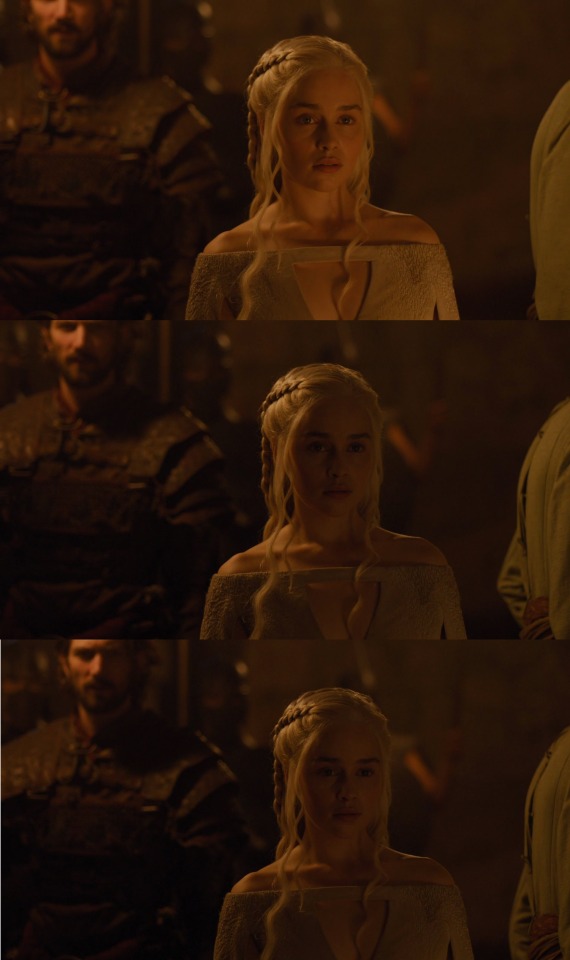

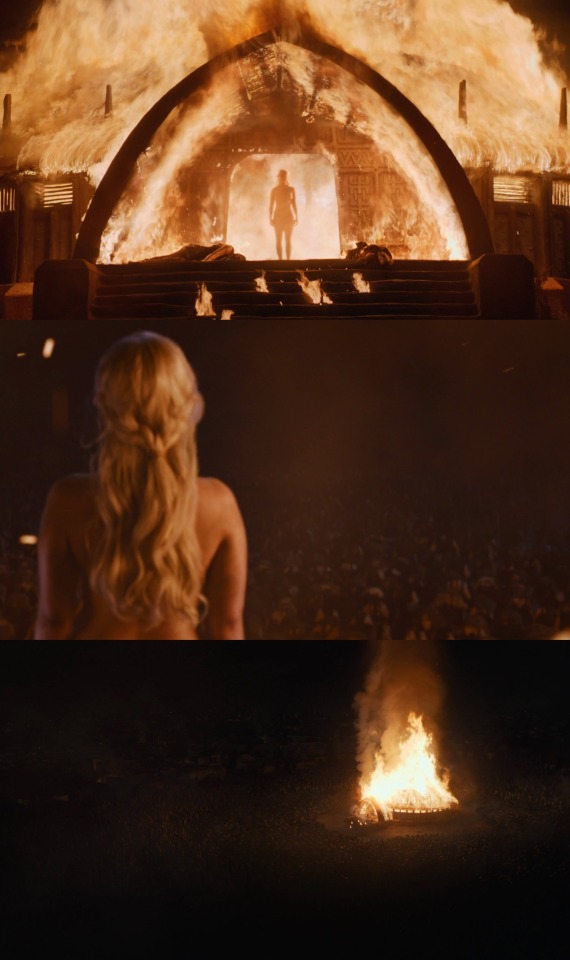
And how can we forget her infamous speech to the Dothraki in S6?
youtube
So, if anyone says that Dany’s actions were nonsensical or out of nowhere, that’s because they weren’t paying attention. I mean, getting what’s “yours” with Fire and Blood? I don’t know what people expected... Rainbows and sunshine and a happy song? The Targaryens are villain-coded for a reason.
“Otherwise, Daenerys has essentially given all of her resources to defend Winterfell based on the promise of the guy in charge and Sansa is still like “Hmmm... I don’t know. I don’t like the cut to her jib”.
I’ll try to keep it short because this is getting repetitive:
Sansa had reasons not to trust Daenerys
Jon Snow might had the title, but Sansa was the true political power of the North
Daenerys did take her armies and dragons North, but that was her duty as Protector of the Realm, since she’s claiming to be the rightful Queen of the Seven Kingdoms
I’ll expand a bit on this part, though: “otherwise, Daenerys has essentially given all of her resources to defend Winterfell based on the promise of the guy in charge”
Since the northern lords elected Jon Snow as King in the North, the true (raw) power lies with the lords. To quote Michel Foucault from the excerpt I transcribed at the beginning of this meta : “But as for power... We know that it is not in the hands of those who govern.” Power is an ever-changing force. It’s always in flux. Political power might be one one side, then on the other (just as it was with the Boltons/Lannisters, then with the Starks), but the true, raw power lies with the people and their desire. The people choose who they want to rule them. As of S7, they wanted Sansa to rule them, but she declines their very kind and subtle offer at treason siding with and supporting Jon. That is until Daenerys arrives and she’s able to form an opinion of her. As of S8E1, she doesn’t trust Daenerys, doesn’t believe her to be their Queen, and even questions Jon’s reasons for bending the knee (something she, and the lords didn’t approve of). Her purpose in the story, since S6, is to play an explicit role in Northern Independence, to finish what Robb started. Daenerys is to Sansa what Tywin and Joffrey were to Robb.
“By the end of the stupid, dumb Battle of Winterfell, Daenerys has proved herself worthy of being a Queen about as well as one can expect in this universe. She’s forging alliances, doing battle, keeping her promises to her followers and to her allies. So Sansa’s stink-eye over Daenerys makes no sense”
As to Daenerys being worthy of being Queen of the 7K, I’ll say it one more time: she did her duty. As claimant of the titles Queen of the Andals, the Rhoynar and the First Men, Queen of the Seven Kingdoms, she’s also claiming the title of Protector of the Realm. The title of Protector is a military one, basically it gives her command of the armies of Westeros. So, it’s part of the job to defend the Realm from any and every threat: that includes ice zombies and the dead, making her war, too, not just “Jon’s war”.
Also, she did what Stannis Baratheon did in S5. Did he do the right thing by aiding the Night’s Watch? Yeah. Was he fitted to be King? Well, he burned his only daughter alive so he could win a fight, so I’d double check that one. It all boils down to the same fact that I’ve been talking about time and time again: doing the right thing for the right reasons. Stannis didn’t do the right thing for the right reasons. And he didn’t make a good king. Sure, he was far better than all the other options available, but he still wasn’t good. Same thing with Daenerys. She did a lot of good things, but all for selfish reasons. Was she a better option from all the others she was fighting against? Yeah, maybe. But she didn’t put any effort in doing right by those people, by doing something that benefitted them and only them. So, was she fitted to be Queen? The answer is no.
Daenerys forged alliances when it benefitted her (she made a deal with the Greyjoys – which included independence btw, since a lot of you seemed to have forgotten – because she needed ships to get to Westeros; Varys forged alliances in her name with Olenna Tyrell and Ellaria Sand – she needed Westerosi allies, otherwise it would’ve been too simple for Cersei to win the war – bringing two powerful regions into her command). But, once Yara and Ellaria were captured, she didn’t even lift a finger to rescue them. It was a great opportunity to show the rest of the nobility that she wouldn’t forsake her allies, that she wouldn’t leave them at the mercy of her enemies. Alas, she did leave them to the mercy of Cersei and Euron. And her reaction to the Lannister forces taking Highgarden? Burn all the food, in a spectacularly stupid way of saying “if I can’t have it, then no one can”.
And since we’re in the subject of allies; Olenna actually sided with Daenerys not because she believed her to be the rightful heir to the throne or because she thought Dany would be a good Queen. Olenna wanted some plain old and simple revenge. She wanted to watch Cersei and everything she worked (and bled and disgraced) for to burn, just like Cersei did with House Tyrell. And what better way to do achieve your revenge plans than with a Targaryen with three weapons of mass destruction? Same goes for Ellaria and the Sand Snakes, they just wanted revenge for what the Lannisters did to Oberyn and Elia Martell (oh, the irony of making the people that want to avenge Elia Martell side with a woman that belongs to the family that was just as responsible for what happened to her and her children as the Lannisters. THE IRONY, I TELL YOU).
So... that’s all I can think of.
I’m sure you expected something shorter, nonny, but when it comes to defending Sansa Stark, I gotta do it properly.
So, I apologize. I know this got out of hand. But the thing is, when it comes to Sansa (and people treating her as an Evil Bitch That Needs To Calm Down™, while claiming D is someone who Did Nothing Wrong™):

Thanks for the ask!
#pls someone read this#this took me longer than it should have#but man that hot take really merit a long-ass answer#you're not fooling me with your big words#you're just like any dany stan i see on this hellsite#or on twitter#anyways#Sansa Stark#sansa stark defense squad#anti daenerys#anti daenerys targaryen#anti dany stans#got#game of thrones#sansa stark meta#got meta#game of thrones meta#anti daenerys meta#my meta#my thoughts#asks#anon#my stuff#to the sweet anon that sent this: i'm sorry
725 notes
·
View notes
Text
Wav Or Aiff For Mac

AIFF is a great audio format, mainly used in Apple Macintosh. It was also developed by Apple in 1998. Pulse code modulation is used in these files. This high-quality format uses uncompressed data. Only an AIFF Player can decode and play these audio files. If you want to listen to AIFF files on your device, you must download a good player. Given below are some of the best available AIFF player choices for you.
Wav Or Aiff For Mac Download
Wav Or Aiff Format
Convert Aiff To Mp3
Wav Or Aiff For Mac Os
Aiff C
Wav Or Aiff
Audio Interchange File Format (AIFF) is an audio file format standard used for storing sound data for personal computers and other electronic audio devices. The format was developed by Apple Inc. In 1988 based on Electronic Arts' Interchange File Format (IFF, widely used on Amiga systems) and is most commonly used on Apple Macintosh computer systems. The audio data in most AIFF files is. Aiff to wav converter mac free download - Free AIFF to WAV Converter, Free WAV to AIFF Converter, AIFF To WAV Converter Software, and many more programs. Choose WAV output format at the main window Format list. Set sample rate and bit depth in the main window. When input file is 24 bit reduced to 16 bit, set Dithering on (check ON and OFF and use, that sound better for you). Select target directory (watch video). Push Start button. Wait until end of conversion and look for converted stuff is placed in the target directory (selected in goal 6).

Wav Or Aiff For Mac Download
Related:

Vlc Player
VLC is probably the most popular media player in the world. It can play AIFF files with good control. VLC is compatible with almost all video, audio formats in the world. If you want to listen to an audio file created on Mac, you must download VLC media player software.
Free Aiff Player
Media player lite is a free AIFF video player designed mainly for Windows users. This software is compatible with Windows Vista, Windows XP, and Windows 7. You can adjust the settings of resolution and bitrate. This AIFF player can also be used as a file converter, capable of doing batch conversions.
Foobar2000
If you are looking for a freeware AIFF player download, Foobar2000 is the best thing for you. It can replace your media player, and it acts as a DVD ripper tool. Foobar2000 allows users to convert audio files to any audio format you like. You can enjoy gapless playback of AIFF audio files.
Other AIFF Player Platforms


If you are thinking about your unconventional operating system and its compatibility with AIFF players, it is time to stop worrying. There are hundreds of AIFF players available on the internet for every operating system. Take a look at some examples listed below, and download the best option for you.
AIFF Player for Android – Poweramp Music Player
This is the best AIFF player for android. It can help you to play Mac audio, video files using an android device. It is not possible to decode and play AIFF files, on an android phone. However, Powerapm helps you play AIFF audio with lyrics. Gapless, crossfade playback is an important feature of this software
AIFF Player for MAC – Audio Music Plan Player
If you are using Mac OS, you must download this software. It has an eye grabbing graphical interface. The menu is available in different languages including Chinese, Spanish, and Russian. You will need iOS 7 or anything after 7, to use Audio music plan player. You can easily customize the interface according to your idea.
AIFF Player for Windows – AIFF Player
You can purchase this amazing software from the official website of Microsoft, for just 2.99 dollars. This is the best way to play AIFF Mac audio files using your Windows OS. The playlists are easily customizable. Different types of audio visualization graphics helps you to experience the music in a different way.
Most Popular AIFF Player – Media Monkey
Media Monkey is the most popular AIFF audio player today. You can easily manage thousands of songs using playlists. Let it be audio books, podcasts, AIFF audios, or MP3s – MediaMonkey will help you to enjoy a gapless playback. The software supports different audio formats as well as video files. You can also see Remix Player Software
What is AIFF Player?
AIFF player is a software program to manage AIFF files. If you are a MAC user, you will know the importance of such a software. People today have different gadgets. If you have a MAC computer at office and Windows at home, it will be difficult to transfer and read data between them. You can also see Music Beat Maker Software
Wav Or Aiff Format
MAC audios will not work on Windows without an AIFF player. There are many extra benefits for using these applications. You can convert audio files into any format you like. Some of them even allow batch conversion. Today, AIFF players can play audios and videos alike.
Read the above descriptions carefully before choosing a particular product. Always remember your exact requirement with such a software. If all you need to do is listen to AIFF files, you can seek an opensource AIFF player download website. If you want a comprehensive media player, it will be better to scrutinize all the features.

Related Posts
Convert Aiff To Mp3
The Free Lossless Audio Codec (FLAC) is the most well-liked lossless format, making it a good selection if you wish to store your music in lossless. While the primary goal of. an audio converter software is to transform audio from one format to a different, there are different features you need to look for to raised manipulate the audio. For instance, a program that may extract audio from video can save you time as you don’t have to use a separate program to do the same. Click on Convert to convert your AIFF file(s).
To convert songs currently in your iTunes library, open the software program and discover the Preferences menu from the iTunes dropdown on a Mac or Edit dropdown on a Windows laptop. Next, click on the Basic tab, then find the Import Settings within the lower part of the Preferences window. After that, click the dropdown subsequent to Import Utilizing, select the format and click on OK to save lots of that import format as the default setting. iTunes permits for batch changing, so the ultimate step is to select all the files you wish to convert, click on the File menu, then select Convert and click on on Create MP3 Version. If you happen to chose a unique output format, it shows that format moderately than MP3.
Audio recordsdata are available various totally different codecs. Some are lossy, comparable to AAC and MP3; they save area in comparison with the unique recordsdata, but a number of the authentic knowledge is lost throughout compression. Some codecs are lossless, resembling Apple Lossless, FLAC, and SHN; these files may be transformed again to their unique kind with out the lack of a single bit. Finally, some are uncompressed, akin to WAV and AIFF; they signify the exact information from a CD or a grasp.
Wav Or Aiff For Mac Os
A most of 18 surround channels, stereo down combine channel and bit stream indicators with non-PCM coded data can also be stored within the file format. RF64 can be utilized in the entire programme chain from capture to editing and play out and for short or long term archiving of multichannel information. He gave me his recording in aiff format for some reason. I pulled it into S1 with no problem and exported it as a stem in wav format so all recordsdata were in the identical folder. As soon as I sync the files collectively I begin to notice a drift because the recording progresses, it is noticeable after a minute or so.
Hamster Free Audio Converter is claimed to work with Home windows 7, Vista, XP, and 2000. • You can even email the converted file URL to others. I have tried removing theaiff extension on sound recordsdata and dragging them into storage band. It worked for a couple of files however it’s actually hit or miss. File any reside classes or unable to obtain music from any online websites.
The worst thing about FileZigZag is the time it takes to add the audio file and obtain the link in your e mail. Nevertheless, most audio recordsdata, even long music tracks, come in a reasonably small dimension, so it isn’t often an issue. Select which audio information you want to merge. These might be added out of your laptop or system, by means of Dropbox, from Google Drive, or from some other online supply that you just hyperlink. You possibly can add a number of files directly or select them one at a time.
Aiff C
Should you’re certain you have got a 16-bitWAV or AIFF file at a 44.1kHz sample fee, and it still will not import into the SPD-SX, then the file might have embedded metadata, or “tags,” that are causing the error. This could happen with recordsdata that come from DAWs (“Digital Audio Workstations”), other audio packages, or sample libraries. You possibly can strip this extra info from the file by changing it to Apple Lossless or FLAC format. After converting to Apple Lossless or FLAC, convert that file back to WAV or AIFF, sixteen-bit and forty four.1kHz.
I do not disagree at all – and I will expand upon this crucial topic quickly. Tagging is the KEY to a correct music system and wendiweathers98.hatenablog.com people get very touchy about it – and understandably so. For those of us that have invested tons of of hours curating and sprucing our metadata, we want that point and personal touch to be honored. I do suppose Roon does not respect that enough.
Wav Or Aiff
Initially, upload the FLAC file by clicking “Add Information” button in this system. Alternatively, you can even upload through the use of drag and drop possibility. The good WMA to M4A Converter can convert WMA to M4A, AAC, WAV, AIFF, FLAC, MP3, ALAC, and AC3. Edit audio file to cut off the unneeded half and reduct the file size. You can convert music or sound to WAV format with free online converter.
The Audio Interchange File Format (.aif oraiff) was developed as the standard audio format for the Macintosh platform, http://www.audio-transcoder.com/how-to-convert-aiff-files-to-wav but it is now supported by Home windows and other platforms. It can support as much as six channels and arbitrary sampling charges and bit depths, with 8 kHz and eleven.127 kHz at 8 and sixteen bits being the commonest online.

1 note
·
View note
Photo

Arcturian Group Dear ones, the world is increasingly moving toward more revelations with regard to negative actions and those involved in them. Be not afraid of what you may see and hear from commercial news sources or your technology for everything that resonates with old energy cannot help but change or actually disappear as new and higher frequencies integrate into the collective.
Many commonly accepted rules, beliefs, and concepts that over time have resulted in today's belief system, must be exposed for what they really represent before those who consider them acceptable will be able to see them for what they really are--programs based in false beliefs and the surrendering of personal power to those who seek it for themselves.
Appearances would testify that mankind is going backwards and reverting to an old state of consciousness. In reality, consciousness is going forward. Each day as higher frequencies of Light increase, more individuals become aware of what up to now has either been sanitized through false teachings or simply hidden behind closed doors.
Allow your light to shine in each now moment of the day for this is what adds to the incoming frequencies of Light flowing from higher dimensions. Accept that you are the one you have searched for over lifetimes. The high resonating energy of each awakened consciousness is what will bring change, expose shadows, and assist the un-awakened to wake up.
All is proceeding according to plan. Rejoice as you witness increasingly more people become aware of the need for change and better ways of living for all rather than a select few. Changes are coming, but don't spend your days waiting and looking for them while dwelling on and adding energy to negative appearances. Rather keep your focus in truth, in the higher frequencies of conscious Oneness with Source and what that means. Remember, you are creators.
Honestly examine how much time and energy you spend thinking about negative issues and learn to be very selective with regard to networking, websites, or groups that easily pull followers into dense energy under the guise of information. Many of you are beginning to recognize an energetic heaviness when visiting certain websites, news sources, or even entertainments.
Be intuitively selective with regard to what you accept into your consciousness. Many sites that began as light fun and interaction with others have become platforms for promoting fear and separation.
Understand that as your consciousness increasingly shifts to new levels, you automatically move out of alignment with some previous interests--online or in person. Attempting to make something from a previous state of consciousness work as it once did is futile and only serves to hold one in bondage to energy that is familiar but which has been outgrown.
Be very honest with regard to how some people, places, or things effect you and have the courage to withdraw from them if they no longer serve. Not only are you changing, but many things that began innocently enough also changed as they were recognized to be excellent platforms from which to to promote an agenda. Always listen to and trust your intuition in these things.
There is much to come dear ones, much that we cannot yet speak about for we do not wish to influence you or cause you to sit back awaiting the arrival of some concept of "savior".
Love yourselves, all of yourselves not just the "good" parts, and allow your inner process to unfold. A great deal of clearing-- physically, emotionally, mentally, and spiritually is taking place at this time. Many of you are experiencing odd symptoms of one sort or another on one or all levels,
The clearing of old energy is individual because energies needing to be cleared result from individual experiences and different lifetimes. One person's process may be to actually re-experience something while another's will simply be to feel exhausted or sick. Allow you process without comparing it to another's.
Allowing indicates a consciousness able to trust that the God/I AM of your being knows how to express ITSELF as and through you without your need to tell it how. In every situation, simply say; "I allow..." rather than "Teach me how to allow" because if your intention is to be taught, opportunities for practice will indeed present themselves.
Rest and pamper yourself when you feel the need but don't endow your clearing symptoms with power. Love and support your physical body as it clears old cellular memory and integrates new frequencies of Light . Speak to your cells telling them to release low resonating energies acquired through inheritance and experience, and allow frequencies of Light to replace them. Visualize bright golden Light moving into each cell and pushing out any shadow as it does so.
Everyone at some point reaches a level of awareness in which they must cease looking to others for love, cooperation, gratitude, appreciation, friendship, support, etc. even from those where it is most expected.
These things are God qualities, facets of Oneness, that human beings in and of themselves do not have to give. Looking to some person for what God alone possesses can only result in disappointment because individuals are only able to express God qualities at the level of their attained state of consciousness.
Every person eventually evolves to a place where they must begin to acknowledge their Oneness with Source and seek only from IT. This then allows whatever is needed, be it the solution to a problem or the receiving of appreciation, to manifest outwardly though the avenue best qualified.
Solutions often appear through a person from whom it is least expected or even a stranger. Never doubt that what you need will appear, often before you know there is a need if you rest always in a consciousness of Divine completeness.
Third dimensional energy is and always has been about looking outside of self for everything. This is because third dimensional energy can only express as duality and separation. Enlightenment means realizing that harmony, wholeness, completeness, abundance, love, acceptance, appreciation, safety, security, and infinite supply are already fully present within never dependent upon outer appearances but rather upon a conscious realization of SELF versus self.
God qualities express and flow through humans, but can never flow from them, simply because human beings in and of themselves do not have these qualities to give. Once you understand this, you stop being disappointed by another's lack of empathy, appreciation, friendship, love, support, or gratitude because you understand that every person is only capable expressing God at their level of consciousness. Everyone is expressing their highest level of awareness.
By not expecting another to give what only God has to give you are loving and allowing them to be who they are at this particular point in their evolutionary journey. At the same time you are allowing yourself to trust that what you may seem to need at any given time already exists within and so you allow the God qualities of your own Divine Consciousness to flow wherever and through whomever is the best vehicle.
In these times of change you are witnessing the disappearance of much that has always been held as being "tried and true"-- facts about successful living that you could rely on. Fear often arises for even the spiritually evolved when suddenly they discover certain solutions no longer work or carefully laid plans fall apart.
You have all lived lifetimes based in mind alone, where plotting and planning was the only acceptable way to resolve issues of any kind. Shifting away from mind alone and into truth and intuition is difficult at first when things begin to no longer work the way they are "supposed" to.
Because almost everyone still carries frequencies reflective of familiar and commonly accepted ways of doing things, panic, confusion, and fear will often manifest as an individual moves to a level of consciousness that requires trust and allowing.
Begin to put everything you have learned about truth throughout this and your many other lifetimes into practice and begin to totally embrace the fact that you are a Divine Being having third dimensional experiences through your own choice.
Spirituality was all well and good and even quite comfortable when it was something discussed in classes, listened to in lectures, read in metaphysical books, given through a psychic, or by meditating now and then. It was something you enjoyed with like minded people and left you feeling "holy" and perhaps even a little "better" than those who didn't know what you did.
That work is complete. You are ready to leave behind spiritual tools based in a sense of separation that promoted struggle in a vain attempts to contact some far away God or become enlightened. You came to believe that spirituality could only be attained through effort, ceremony, right practices, and a whole lot of work. You now know that everything you sought through these practices is within.
You may still be guided to seek help from a certain teacher, book, or class to help you move through a "stuck" place, but spiritual tools are never intended to become one's lifeline. A continuing reliance on anything outside of SELF simply prevents one from realizing that everything they need is fully present within. The books, classes, crystals, mantras, and gurus necessary to one's earlier steps are meant to be bridges leading within.
Example; Crystals carry unique and often very powerful energy, but are meant to align with and strengthen this same energy within the individual, rather than give them something they don't already posses.
Those of you who are spiritual teachers in some capacity must keep in mind that it is vitally important that you never allow human ego to keep your student coming after they are ready to go "solo". A spiritual teacher's job to give wings to each student as they lovingly guide them toward realizing their Oneness with Source.
Integrate each truth as it reveals itself to you and live from your highest attained level of awareness. At some point IT begins living ITSELF as you without effort or study on your part. Most of you are either already there, or close to it or you would not be drawn to or even understand these messages.
Let go dear ones. Let go and jump off that spiritual cliff you have teetered on for so long. Allow your Divine self to be your sword and shield. Accept that you really are a Divine expression of God in material form and never have been a powerless human subject to all the manifestations of duality and separation.
I AM everything I have sought for lifetimes...there is no longer any need to keep seeking.
9 notes
·
View notes
Text
//Yesterday I mentioned that I would talk about Frost’s new gear, since I’ve analyzed it before and talked about it, the names chosen for her cosmetics have a lot of meaning when it comes to its cultural background or anything around it that could be related with Frost. Good thing is that since Aftermath came out, a lot of things for many characters did as well, and y’all know I love this cyborg’s design a lot, so let’s begin with her power arrays.

Cordelia:
The name itself doesn’t have a clear meaning, but surely the name rings a few bells if you’re familiar with ‘King Lear’ by Shakespeare (inspired by real events). Cordelia was one of the 3 King Lear’s daughters and his favorite. To know how to divide the lands, he asks the daughters which one loves him the most, which Cordelia says ‘according to my bond, no more nor less‘. But Lear is not someone who uses his head for good and is infuriated with the lack of commitment to show love from his favorite daughter, and makes her vanish from his kingdom, to which is the beginning of a time of chaos in the life of the king. Spoiler alert: both father and daughter are taken to prison by their enemies (also, she comes back to aid him in the middle of his madness), and she is hung and dies but her body is taken by Lear for others to see, and is grief the final cause for his death to which he dies next to her. Of course, there are common points and not so common, along with the belief that Cordelia was a tragic character (and Frost is a tragic villain) no less. If we take in consideration the different parallels between Cordelia and Lear with Frost and Kuai: being the favorite, pushed away by their actions and finally dying before the eyes of that one who loved them before (of course, a big thing to notice here is that Lear is more obscure than Sub-Zero all the way if we analyze his character more).

Qingniao:
There’s a lot of names in her power arrays related with mythological figures from different cultures, most of them related to either femininity, the moon or the ice itself. However, Qingniao is different since it is not related to a goddess but to a creature. The qingniaos according to Chinese mythology were these blue (or green) birds, some of them had even three legs or just one and they were the messengers of the Queen Mother of the West Xi Wangmu, a goddess that it was believed could provide long life and prosperity, even some religions in China consider her as their central deity. These birds to the goddess were of high importance since they not only allowed her to deliver messages across the lands but also retrieve food for her as well. It’s pretty obvious why this name fits so well and shows the high importance and relation between Frost and Kronika (Titan - Henchwoman).

Oreade:
This time, this power array has the name that was used in Greek Mythology to refer to the nymphs guarding and living around the forests close to the different mountains, each mountain had a group of specific nymphs that would protect it, in fact, the most known oreade is no other than Echo. She was the nymph who fell in love with Narcissus and her voice was taken away by Hera, only being capable of repeating the last word someone spoke to her. The name for this power array honestly doesn’t have too much relation with Frost, but we could say that she is, somehow, a protector of the Hourglass since without its control, Kronika (or herself in her tower ending) would never be able to bring the New Era.

Ice Demon:
This is by far my favorite along with Quaestor and Birka Viking. Demons in the universe of MK are pretty common (hell, there’s even a whole realm that they habit). Other ninjas in the game have demon themed gear, especially when it comes to their masks, but this time we have that influence in this power array. Perhaps, what is safe to say, that is heavily influenced by the Japanese Onis but also by the Yaoguais, monsters considered by the Chinese folklore as evil spirits of any kind searching for immortality and becoming deities themselves. This relates heavily to Frost since her form to attempt to achieve both was through cyberization, and considering her personality, she could be easily related to the temper of a demon like the Yaoguais, constantly searching to harm divine creatures and humans.

Arctika:
Geographically speaking and according to the lore of the game, Arctika is actually a place beneath the mountains in China were the Lin Kuei Temple resides and this place has never been peaceful since the very beginning. The name of this power array goes along with her mask ‘Daughter of Arctika’, let’s not forget the huge importance that those cold lands have for Frost as a cryomancer and considering her wishes to be the Grandmistress of the Lin Kuei (not taking in consideration the lengths she takes to do it). For both her and Sub-Zero these lands have a higher meaning in their souls, they are around their own vital element that is the ice, and is no coincidence that both have gear pieces named after this place, also is where they first meant when the tournament for the new recruits would take place. A thing to notice is it’s distinctive design since it looks less like the other power arrays and more like a jet pack.

Ice Fury:
It is not a casualty that most of her gear refers to her personality since it’s what stands out the most when it comes to her and the treatment to other people, Frost is known to not be the most chill person to be around and having issues with her rage. Not only that is a quality of her personality that stands out at first glance, but also her fighting style. If we compare her fighting style with Sub-Zero the first thing we would notice is how much chaotic she is and violent with her moves, I’m not saying that Sub-Zero’s fighting style is less lethal, but is much more collected than Frost’s, considering that she is a cyborg and this allows her much more possibilities for her powers and how to use them, her entire body is a weapon of destruction and when Frost uses her ice powers in combat, her abrasiveness goes along with her movements and passion for defeating her enemies.

Chosen by Kronika:
We know for a fact that Kronika, the Titan who is (was) in charge of the course of time since the very beginning of the universe and master of The Hourglass, was the one who gave Frost an important place to take by her side, her gift to the cryomancer for fighting by her side for the New Era was to be superior than any human since she could see the full potential that this woman had in her soul. Kronika cyberized Frost for proving her loyalty to the cause and also be the Grandmistress of the Lin Kuei once their plans succeded completely. We see that Frost is proud to work by her side, logically she’s given an armor that goes along with both Kronika and Geras, who’s also another important agent that helps Kronika to achieve her goals. The name for this mask says a lot about how Kronika perceived Frost, or at least how Frost perceived herself when it comes to decoding what place she takes part in all of this.

Slayer of Sektor:
This name is pretty clear and tells exactly how things worked between Frost and Sektor, even if she would the Grandmistress in the New Era, her compromise with the Cyber Initiative was shared with Sektor, the same Lin Kuei who cyberized a generation of his clan back in the 90′s. The name for this mask could give us a hint about the kind of roles they played when it came to cyberize this new generation of Lin Kueis, we could say that Sektor was the one who organized and made the initiative function considering that he was the one who started everything, and Frost would be mostly in charge of retrieving the subjects for the transformation or even working as his protector (is never favorable to lose the head who has thought about the whole initiative if you think about it).

Northern Lights:
Also known as Aurora Borealis, the Northern Lights is simply an atmospheric phenomenon that happens commonly close to the north or south pole, to make things short, is what happens when particles of the sun that are electrically charged with energy collide with the atmosphere of the planet and since the air is full of different types of gasses, the colorful phenomenon happens. Also, to take things in consideration, ‘Northern Lights’ was the name of one of Frost’s moves back in Mortal Kombat: Deadly Alliance, it was only allowed to input while fighting with the Tong Bei style. If we notice the design of the mask, it might resemble the mouth of an Oni/Yaoguai but it could also resemble the mouth of a dragon, considering the high importance that these creatures have in Chinese Folkore and the fact that the Dragon Medallion was the object of desire for Frost in the Original Timeline.

Pure Ice:
The name is pretty descriptive already since it’s highly related to her ability, but what stands out the most is the Lin Kuei symbol on it, again, this mask is another that pays homage to her origins and how her destiny is tied with the clan she wants to rule over.
I would continue with her frozen cores but the issue is that the names they have are too specific and related with the origins of her technology so it is not exactly what I’m intended to talk about (and the names are also kinda confusing if you ask me).
4 notes
·
View notes
Text
Writing in Comic+Illustration
“A picture is worth a thousand words.” I have to admit that’s a pretty cliche starter, but it does help define what writing means in the art community.
One way to define “writing” is to call it a genre.
Genre 101
Before I continue, I want to make sure that you understand what I mean by genre. When I talk about genre I am simply referring to various forms something comes in. For music its different sounds like the genre of jazz or pop. In writing, a genre is a book or a shopping list. Hopefully that clears things up!
When I first began researching various writing genres in the art community I was confused because I thought I was looking for actual written texts like a research paper. Yes, there are the conventional forms of written genre within the art community like a blog, but turns out a genre in the art community simply refers to the art we create!
“I thought art didn’t have writing?”
Comics, manga, anime, ads, posters- those are all forms of genre in the art world. If you are still confused then just think about the different forms that you often see art as.
In our community, the purpose of these different genres vary between the mediums.
Some are for insiders (people who are artists themselves) some genres cater towards outsiders (people who are not artists, but consume and enjoy art).
As an artist, our main focus is to entertain others with the works of art we create. Because the nature of our job focuses on pleasing others, most genres of art are created to be consumed by outsiders.
To illustrate that let’s compare two different kinds of art projects.
Genre 1: Comic Book
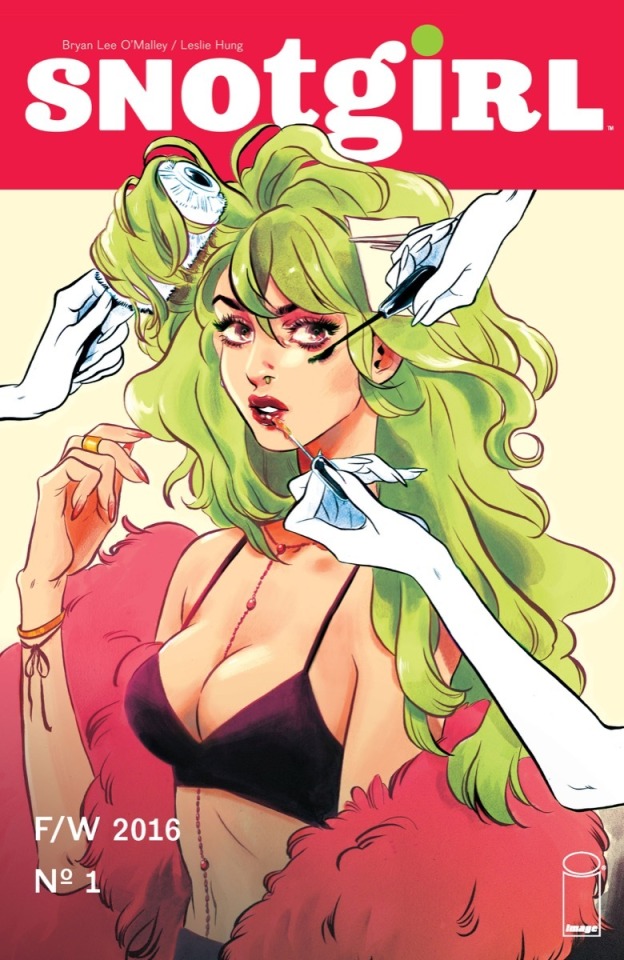
SnotGirl by Bryan Lee O’Mallley/Leslie Hung
Who is it for?
Comic books come in various styles and not just what people typically think like the Marvel comics.
A comic book is written in order to entertain an outsider of the art community. That is not to say that artists do not enjoy comics as well, in fact I’ve included one of my favorites as the example!
Sometimes comics are a single page with multiple panels, and they can span multiple pages and volumes. Snot girl, for example, is currently on its 14th issue!
A comic is a very commonly produced genre. Typically, someone who writes a comic has multiple reasons to do so. Most of the artists have their own story to tell. They have created their own characters, their own world, and have a vision or lesson they want others to see as well.
What’s so special about it?
What’s great about a comic is that there is no right way to do it. Comic artists are tasked with balancing multiple parts of their project. They have to consider:
- the organization of the dialogue
-how they are going to lay out the images/ what geometric shapes the panels will be
-inclusion of sound effects
Don’t forget the art itself! The creator has to make sure they are:
- cohesive
-complete and dynamic illustrations
- they do not clash with the already established panel placement
-establish the tone and mood through colors and lighting
When Less = More
Comic books have the daunting task of developing their writing through narration and dialogue. Write too much and the reading becomes heavy and write too little and the author risks confusion.
Imagine condensing an entire essay into dialogue between characters with limited narration. Writing in comics is an art in-and-of itself.
While the writer of a comic and also be the artist, this isn’t a set rule. Sometimes the author and the illustrator are two separate people or teams!
SnotGirl as a comic book case study:
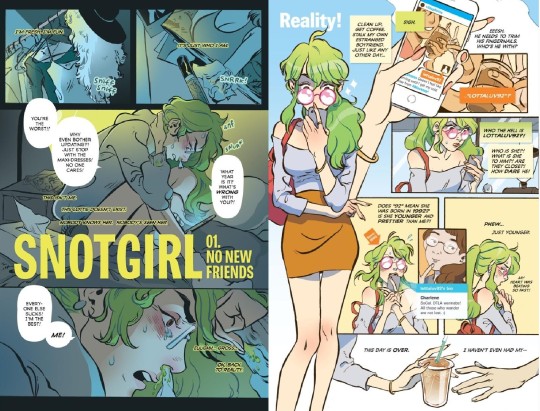
Volume 1, SnotGirl
Analyzing structure
The left page is split into three rectangles and the right page is broken down into multiple squares beside a near full body illustration of the main character, Lottie.
Lottie lives her life as an Instagram model and fashion influencer. The left page introduces us to the real Lottie, a side of her that is disgusting and unkept, snot drizzling out of her nose constantly. The right page shows her in public maintaining an idealized and aesthetic persona.
if you break a page into three sections that means more art needs to go into a single panel. In the middle rectangle her whole body is shown and the bottom panel is largely zoomed into her face. It’s nearly claustrophobic, showing Lottie’s overwhelming insecurities and having the reader up-close to a side of Lottie she wishes to ignore.
On the left page, the dialogue reads as frantic, narcissistic, Lottie is trying to convince herself that she doesn’t feel ugly and that she’s more superior than others.
On the right the multiple squares include more dialogue, space around Lottie, and more zoomed-out compositions (For example, you can see Lottie all the way down to her chest at least four times).
The squares reflect Lottie’s insecurities but they are the problems of her perfect persona: boy troubles, getting coffee, and Instagram profiles. There’s more writing on this page to reflect her more superficial ravings.
Analyzing illustration
Art wise, on the left the colors are grey, dark green or blue, and more cool-toned. In color theory cool tones portray sadder, more serious moods.
The right page which is vibrant and warm-toned, which is supposed to be energetic. If I were to ask you, you might be more attracted to the right side and its happier atmosphere.
These two pages illustrate how color, composition, and organization differ widely to emphasize how the artist wants the reader to feel and understand about the story.
Sounds complicated doesn’t it? The genre of comic books may be common, but it takes a lot of working, planning, and dedication.
Genre #2: Video Game Illustration
Illustration in game

illustration in full

Art by ZAVIR
Aren’t games 3D though?
I know that when most people think about video games the models and backgrounds are in 3-D. Think of Red Dead Redemption 2. While most mainstream games are produced that way, there are still many games who use illustrations like PC click-and-point games, mobile games, and other games use illustration for character sprites. The example I’ve included is from my favorite mobile rhythm game, Cytus II.
For those who don’t play Cytus II, the game revolves around different in-universe musicians who have different songs which the player taps the beat to. For each playable song there is an illustration. (Here’s a link to the hardest song in the game! “Floor is Lava”)
What’s the point of the art?
Most video game illustrators work in backgrounds or character sprites. The illustrations can be single items as well, clarifying items that a character may have picked up in game.
However, to stay relevant to my example I will mainly focus on the aspects of this particular video game illustration.
Cytus II as a case study:
The illustrations in Cytus 2 are meant to:
create further diversity between the different songs
provide the song with a visual outside of the beatmap
By providing the song Extinguisher by Lixound with artwork, it’s not only visually pleasing but adds memorability to the song. People who are fans of the game can now draw fanart of the song.
Differences from comics
there is very little text.
The story or context has to be told by the artist in composition, character pose, and other artistic choices like lighting or colors.
Particularly in Cytus 2, the story the artist tries to tell is set by the sound and “vibe” of the song.
“Extinguisher”, an EDM song, has fast beats and dubstep like qualities as well as a robotic vocal track. It’s chaotic and fast, which could explain why the artist interpreted explosions and a figure that looks like an anarchist.
Why Different Genres Exist: Comics vs Video Game Art
Imagine if a comic was told through dialogue-less illustrations and imagine if video games had backgrounds and illustrations that were formatted like comics.
Visual chaos would ensue. Clashing dialogue, images, colors, and a lack of clarity for what the viewer should be focusing on.
Thank goodness for the different genres of illustration, huh?
1 note
·
View note
Text
Isa’s TRUE Personality: The Beautiful, Tortured, Selfless Moon Goddess of Love (Part 1)
Saix’s weapons are an absolute goldmine of esoteric symbolism. There’s no way I can cover it all in one post; there’s just too much. But I want to do a series analyzing everything, to show just how differently his character ended up in canon, compared to how it was originally conceived. I think the original idea for Isa’s character and his relationship with Lea is extremely unique and utterly fascinating. According to the symbolism, Isa’s TRUE personality is exactly as the title describes. A tortured, beautiful, selfless Moon Goddess of Love who was clearly intended as a love interest for Lea.
Part 1: The Tortured Moon Goddess
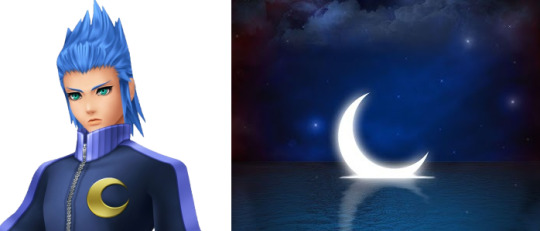
Cool, collected, and mature beyond his age. He’s good friends with Lea.
— Jiminy’s Journal (Kingdom Hearts Union χ)
Saix’s title, Luna Diviner, is a reference to Selenomancy, named after the Goddess Selene. It is a specialized form of divination that examines the various aspects, phases, and appearances of the moon. According to diviners, moon phases are associated with certain personality types at the time of birth. There are several specific moon phases used as names for Saix’s weapons. Gibbous represents someone who is a healer and humanitarian. They care about other people; sometimes more than themselves. The pain and suffering of others is something that they are not only highly sensitive to, but also want to help transform.
Balsamic Moon, is the waning crescent that is the trademark symbol on Isa’s jacket. It’s the final phase of the moon. This is a phase of decline and darkness—a rich opportunity for your soul to experience. It is considered the most Yin or Feminine phase. Balsamic means soothing or restorative. If you are born under this Moon, you will be aged and mature in some way. Balsamics are quiet, retiring and resilient; they are often seen as “old souls”. They are complex and wise beyond their years, as well as loners who usually only enjoy the company of a select group of people.
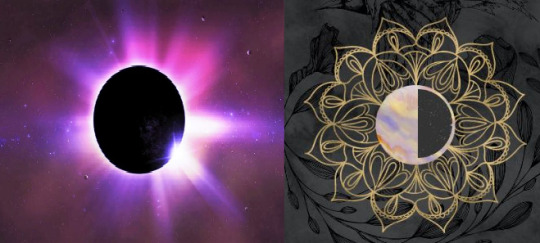
New Moon is also known as the Dark Moon. It is the phase where the Moon’s energy is weakest. Even though the New Moon is invisible in the sky, those born under it are cloaked in darkness. They tend to lack self-awareness. They may be known for being selfish, callous, or unable to see things from other people’s perspectives. This weapon has the same shape as Berserker and Werewolf.
Saix’s Pandora Gear is Dichotomy. This word has several definitions. It means “a division or contrast between two things that are entirely different.” Or, “the phase of the moon in which half its disk appears illuminated.” It represents the clear division between the past and the present, Isa and Saix.
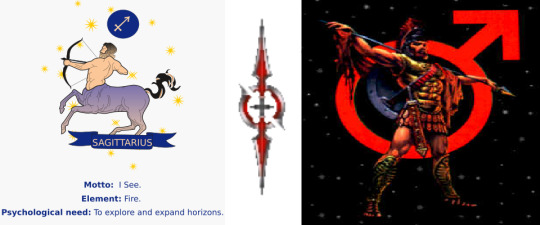
Many of Saix’s weapons incorporate ♐︎ the astrological symbol of Sagittarius into them. I believe ♐︎ is meant to represent Lea. Sagittarius is a part of the Fire Trigon of the Zodiac. As an archer, he is said to never fail in hitting the mark. Sagittarius represents the centaur Chiron, an immortal centaur, who was renowned for his gentleness. After being accidentally shot by a poison arrow, he was in agony, but unable to find release in death. So he decided to offer himself as a substitute for Prometheus, who was punished by the gods for giving fire to man. Zeus saw the kindness of Chiron and immortalized him in the stars.
Axel’s weapon Prometheus is a combination of ♐︎ and the symbol of Mars ♂, and ALSO ♋ the Cancer symbol. Mars was known as the Roman god of war. He was said to love the violence and conflict. He carried a spear that was often depicted as covered in blood. He was the patron God of soldiers and was worshiped prior to battle. Soldiers in the Roman Army prayed to Mars before battle, hoping that he would protect them and lead them to victory.

Selene is shaped like a torch combined with ♐︎ the symbol of Sagittarius. In ancient Greek mythology, Selene is the Titan goddess of the Moon and is said to drive her glowing chariot powered by beautiful white horses across the sky each night. Her symbols were the crescent moon, a chariot, and a torch. Selene was very well known mostly because of her beauty. She was a very peaceful goddess and did not approve of war. Her personality was said to be secluded and timid.
Most Ancient Greeks looked to her for healing. Selene also had many powers that you would not think a moon goddess would have. Mythology states that she had powers surrounding dreams, she could harness the ability to awaken intuition and she could also catalyze psychic visions. As the patron of femininity, she was known to have the power to ease childbirth, to inspire love, to mask reality, and to pierce illusion.
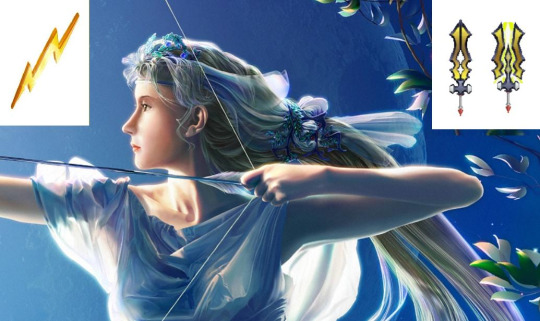
Artemis has been commonly associated with Selene. She was the goddess of the Moon, the ruling planet of Cancer, and the daughter of Zeus. Her personality was individualistic and free-spirited, yet kind. She was a patron goddess of hunting and childbirth, and she was also the protectress of little children and baby animals. In Greek mythology, Artemis was usually portrayed as a very tall, beautiful young maiden with a hunting bow the shape of a crescent moon and golden arrows. She is often accompanied by either a stag or a dog. One of her special talents is calming animals, meaning that when she walks near them they come towards her and become calm.
Artemis is one of the ‘virgin’ androgynous goddesses, along with Athena and Vesta. Due to her well-integrated masculine energy and independence, she possesses an introverted temperament, preferring solitude. She was also known to be friends with mortals. Her assets were courage, confidence, and strength (both mental and physical). Her weaknesses were vengeance, impulsiveness, and being quite aloof. She was afraid of men, which is why she used to live in the woods and only went for walks at night. She rarely had any male companions; she only loved one person, Orion, but she ended up unintentionally killing him due to trickery. In her pain she appealed to Zeus to immortalize Orion in the stars so she could be with him.

A quiet and cool-headed youth. Though he does come out of his shell when talking to his best friend Lea, toward others he is distant and untalkative. Often scolds Lea and his contrasting personality.
— description from KHBBS Light Novel 2 (Best Friends)
The design for the weapon Astrologia incorporates ♋, the sigil of Cancer into its design. Cancer is associated with Artemis, who is similar to people born under the sign of Cancer. They are very modest, shy, and extremely emotional individuals who love children and pets. Artemis exemplifies the caring, nurturing and protective qualities of the mother. Deeply intuitive and sentimental, Cancer can be one of the most challenging Zodiac signs to get to know, but they are sympathetic and very attached to the people they keep close.
Being ruled by the Moon, they are mysterious— they can struggle with sharing their innermost feelings. Cancer was known as the “dark sign” because of the obscured visibility of its constellation in the night sky. They have a tendency to brood and can be very moody and pessimistic. They often don’t have enough coping and defensive mechanisms for the outer world, so they can be prone to introversion and slow to warm to strangers. Cancers are quick to retreat into their shells if it suits their mood. The crab is a perfect symbol for the Cancer sign, symbolizing how a sensitive soul hides beneath a tough exterior.
A Cancer is caring and vulnerable, however callous they may appear on the outside. They are introspective and serene folk, who love solitude yet care gently for the people surrounding them. This receptive nature, however, makes them easily hurt. Cancer is the most emotional sign of the zodiac but at times they might appear icy and separated. Empathy for others is likely to be strong, and they will have an intuitive ability to sense what others need. They have a tendency to be quite clingy. Cancer’s shyness comes from their insecurity and deep fear of rejection. They are a cautious and shrewd people.
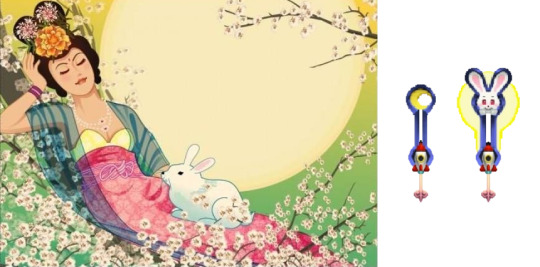
Moon Rabbit is known as the Jade Rabbit in China. The Jade Emperor disguised himself into a poor, starving old man and begged for food from monkey, otter, jackal, and rabbit. Rabbit could only gather grass. Knowing well enough that grass can’t be offered as food to humans, rabbit decided to offer its own body, sacrificing itself in the fire the man had started. Somehow, though, rabbit wasn’t burned. The old man suddenly revealed himself to be the great Jade Emperor. Touched deeply by rabbit’s selfless sacrifice, he sent it to the moon to become the immortal Jade Rabbit.
More than just cute, fluffy, and white, the Jade Rabbit is a sign of selflessness, piety, and sacrifice. The Jade Rabbit is on the moon so that no matter where we are on Earth, we always have the ethics of righteousness and self-sacrifice to look up to. In East Asia, the Jade Rabbit is a widespread cultural symbol. When the bunny isn’t busy making immortality elixirs, it keeps the beautiful goddess Chang’e company in the Moon Palace.
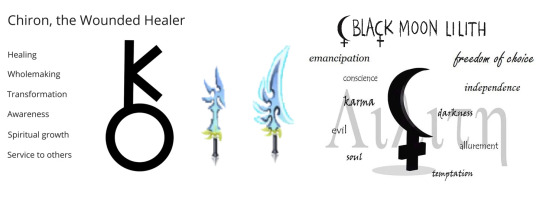
Saix’s weapon Crescent is based on the Phoenix’s wings. This weapon represents the albedo stage of magnum opus. Following the chaos of the nigredo stage, albedo involves the washing away of impurities. In this process, the subject is divided into two opposing principles to be later coagulated to form a unity of opposites during rubedo. The aura is light blue, meaning truthfulness and serenity.
Psychologist Carl Jung equated the albedo stage with “unconscious contrasexual soul images; the anima in men and animus in women”. Jung described the animus as the unconscious masculine side of a woman, and the anima as the unconscious feminine side of a man, with each transcending the personal psyche. This makes albedo a phase where insight into the shadow side of the self is gained, while inflated ego is removed from the psyche.
So, that makes it VERY interesting that the weapon has a similar shape to ⚸. Even if they never planned to actually show it explicitly, the writers seemed to be inspired by Black Moon Lilith. Which raises very disturbing (though very interesting) implications about what happened during the experiments on the “darkness of the heart”. It would certainly explain how Axel’s personality became so warped. It would also explain why he didn’t find Saix’s personality change that unexpected, either, and why Axel seemed to always give him the benefit of the doubt no matter how cold he was.
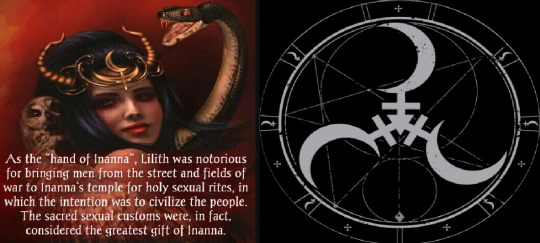
Astronomically, Lilith is considered an asteroid. Yet, some astrologers identify Lilith with the “Black Moon”. It’s the mathematical point that’s exactly in between the earth and the moon–essentially, empty space. Astrologically, it represents the cosmic void; the very energy Black Moon Lilith embodies. Psychologically, it is a point that represents how we react to emptiness and isolation. It brings up deep and primal issues like repressed feelings of rejection, rage, and the refusal to give in. This particular archetype is associated with sex, death, obsession, addiction, transformation, resurrection, magic, the occult and the taboo. These things are seen as the entry way between the spiritual dimension (or the underworld), and life on the physical plane.
Put simply, Lilith is the dark side of the moon. She represents animus, the feminine shadow side—What society rejects as appropriate for the feminine, Lilith takes up. The vilest manifestations of sexuality like pedophilia, rape, and satanic ritual abuse are all the domain of Lilith. She was actually said to be a hermaphrodite, so she could act as both a succubus and an incubus. Trauma based mind-control, through the use of sexual torture is another area connected with Black Moon Lilith. She symbolizes the transformation that occurs after going through a dark night of the soul. Usually, the trigger is great suffering, mourning, pain or torture. I can only imagine what poor Lea and Isa must have gone through.
Astrologically, Chiron (Sagittarius) stands in total opposition to Black Moon Lilith and all she represents. He is a symbol to remind us to look at the vulnerabilities we face in light of our connection to Divinity. Through the exploration of our wounds, we are called to heal all that creates a rift or disconnection with our Spirit.
#kh lea#kh meta#kh isa#kh#kingdom hearts meta#anti-kh3#kh saix#kh 358/2 days#isalea#akusai#kh akusai#kh leaisa#leaisa#kingdom hearts#kh theories#kh axel#kh isalea
59 notes
·
View notes